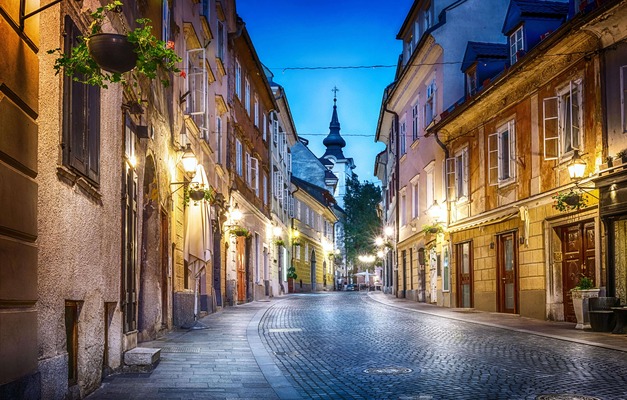
Jewels of Europe: Art, History and Waterways in Paris, Amsterdam, Berlin, Prague, Vienna & Budapest
 21 Day Tour of Paris, Amsterdam, Berlin, Prague, Vienna and Budapest
21 Day Tour of Paris, Amsterdam, Berlin, Prague, Vienna and Budapest
Overview
Trip Map
Itinerary
Inclusions
Reviews







21 Days 20 Nights
Best Time: Jan-Dec
Visiting Museums & Art Galleries
Day Cruises
Take a captivating multi-country tour through Europe's heart. Visit Paris, Amsterdam, Berlin, Prague, Vienna, and Budapest, each full of must-see sights and unique history, art, and culture. Meander through the corridors of world-renowned museums such as the Rijksmuseum and Musee d'Orsay, perusing art from Van Gogh, Da Vinci, and other masters. Feel the gentle breeze on leisurely cruises, drifting along scenic waterways like the Danube and Seine. Enrich your journey with private guided tours with a local in each destination. You'll also enjoy detailed travel guidance, ensuring a seamless experience.
- Glide along the serene Amsterdam canals and experience history reflected in the waters
- See the Mona Lisa and countless other masterpieces in Paris's Louvre Museum
- Let the imperial splendor of Prague Castle and Vienna's Hofburg Palace captivate your imagination
- Pass through Berlin's Brandenburg Gate & Checkpoint Charlie and climb the Reichstag's glass dome
- Witness the magically lit Hungarian Parliament and Buda Castle on a Danube cruise in Budapest
Take a captivating multi-country tour through Europe's heart. Visit Paris, Amsterdam, Berlin, Prague, Vienna, and Budapest, each full of must-see sights and unique history, art, and culture. Meander through the corridors of world-renowned museums such as the Rijksmuseum and Musee d'Orsay, perusing art from Van Gogh, Da Vinci, and other masters. Feel the gentle breeze on leisurely cruises, drifting along scenic waterways like the Danube and Seine. Enrich your journey with private guided tours with a local in each destination. You'll also enjoy detailed travel guidance, ensuring a seamless experience.
- Glide along the serene Amsterdam canals and experience history reflected in the waters
- See the Mona Lisa and countless other masterpieces in Paris's Louvre Museum
- Let the imperial splendor of Prague Castle and Vienna's Hofburg Palace captivate your imagination
- Pass through Berlin's Brandenburg Gate & Checkpoint Charlie and climb the Reichstag's glass dome
- Witness the magically lit Hungarian Parliament and Buda Castle on a Danube cruise in Budapest

Louvre Museum
Museums & Galleries

Old Town
Historic Landmarks

Museum Quarter
Museums & Galleries

The Brandenburg Gate
Historic Landmarks

Prague Castle
Castles & Chateaux

Central Market
Street Markets
Must see sights

Louvre Museum
Museums & Galleries

Old Town
Historic Landmarks

Museum Quarter
Museums & Galleries

The Brandenburg Gate
Historic Landmarks

Prague Castle
Castles & Chateaux

Central Market
Street Markets
Starting from
$5789
per person
 Not included
Not included Secure Your Customizable Trip
Enter your details to embark on a journey that can be tailored just for you.
Start
Travelers
Add Room
Remove Room
Preferred Hotel Stars
Craft Your Own Itinerary
Select your interests and destinations for a trip plan inspired by you.
Trip Map & Itinerary
Enable/Disable Map Scrolling
Click To Make Map Interactive

Trip Timeline
 Edit Details
Edit DetailsArrival
4 nights
Paris
France
Train: 3.5h
3 nights
Amsterdam
Netherlands
Train: 6h
3 nights
Berlin
Germany
Train: 4.5h
3 nights
Prague
Czech Republic
Train: 4.5h
3 nights
Vienna
Austria
Train: 3h
4 nights
Budapest
Hungary
Departure
Day-By-Day Itinerary
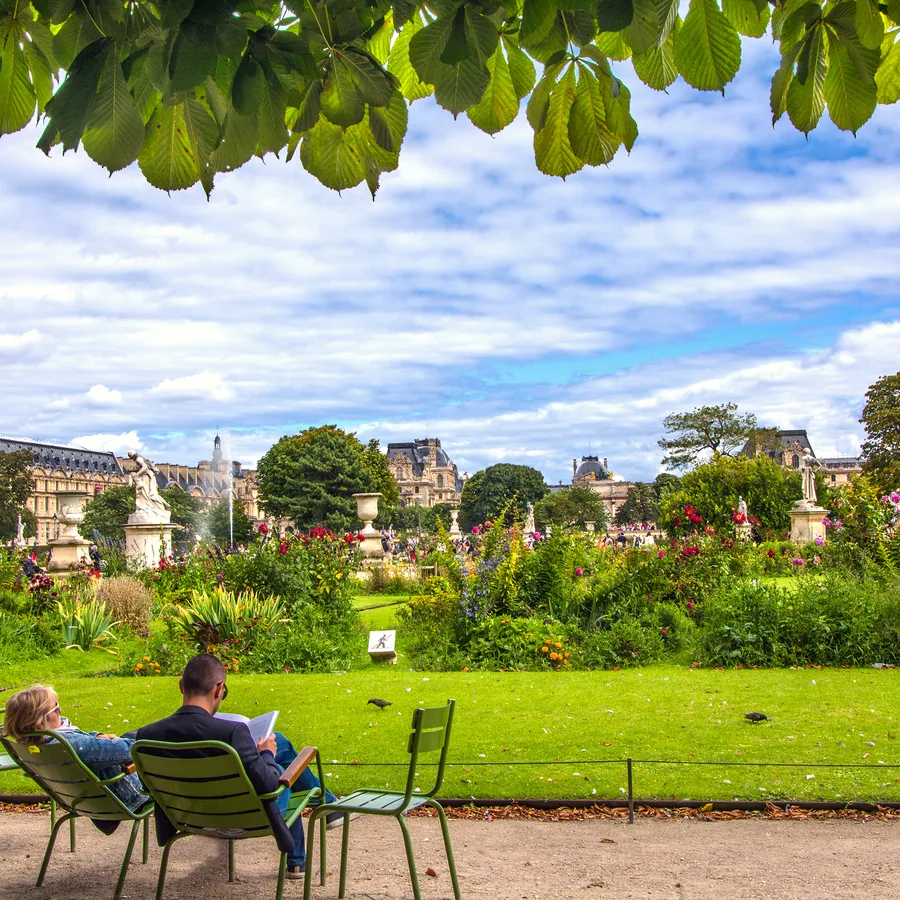
Day 1
Arrive Paris
View More
Day 1
Arrive Paris



To Be Determined
Arrival in Paris Airport & Transfer by Taxi
Upon arrival at one of Paris's Charles de Gaulle or Orly Airports, it's fairly easy to catch a taxi from outside the main terminal building to your hotel. This is cheaper than a pre-arranged private transfer, although that option is also available if you wish - just ask your consultant. Parisien taxi drivers are generally reliable and honest, but we will provide you with instructions on how to avoid possible scammers and charlatans. If you want to save money, and often quite a lot of time as well, we will also give you alternative instructions on taking public transport into the city center. Details are contained in the full itinerary and mobile app available to our travelers. If on the other hand, you are arriving at Paris's third airport, Beauvais Airport (BVA), then you should always take the shuttle bus. The taxi fare might cost more than the flight - it's nearly 50 miles (75km) outside the city.

Day 1
Arrive Paris
View More


Day 1
Arrive Paris




To Be Determined:
Airport Taxi Pick-Up
Mid-Day/Afternoon:
Tuileries Gardens & Nearby Museums
Late Afternoon/Early Evening:
Hôtel des Invalides


Day 2
Paris
View More
Day 2
Paris



9:00 AM - 1:00 PM
Private Guided Walking Tour of the Center of Paris
Embark on a captivating 4-hour walking tour of the center of Paris, the City of Lights, where history and modernity blend seamlessly along its enchanting streets. Starting from your accommodation, you will explore the heart of this dynamic city and learn how to navigate Paris as a local.

Day 2
Paris
View More



Day 3
Paris
View More
Day 3
Paris



Early Morning/Morning
All You Need is Louvre - A Visit to the World's Largest Art Museum
It might be the greatest art museum in the world; it certainly is the largest with over 380,000 objects; to view every single one for even a minute apiece would take 75 days. And those descriptions still don't do the building and its collection justice. Marvel at treasures inside, including Leonardo Da Vinci's mysterious woman, the Mona Lisa, and everything from an Egyptian masterpiece of mummification to the famed Hellenistic sculpture, Venus de Milo, to patriotic French masterpieces like Delacroix’s Liberty Leading the People. Although the Louvre is vast and ever-crowded, with some strategy and a few helpful tips your visit will take in maximum artworks with minimal hassle.

Day 3
Paris
View More


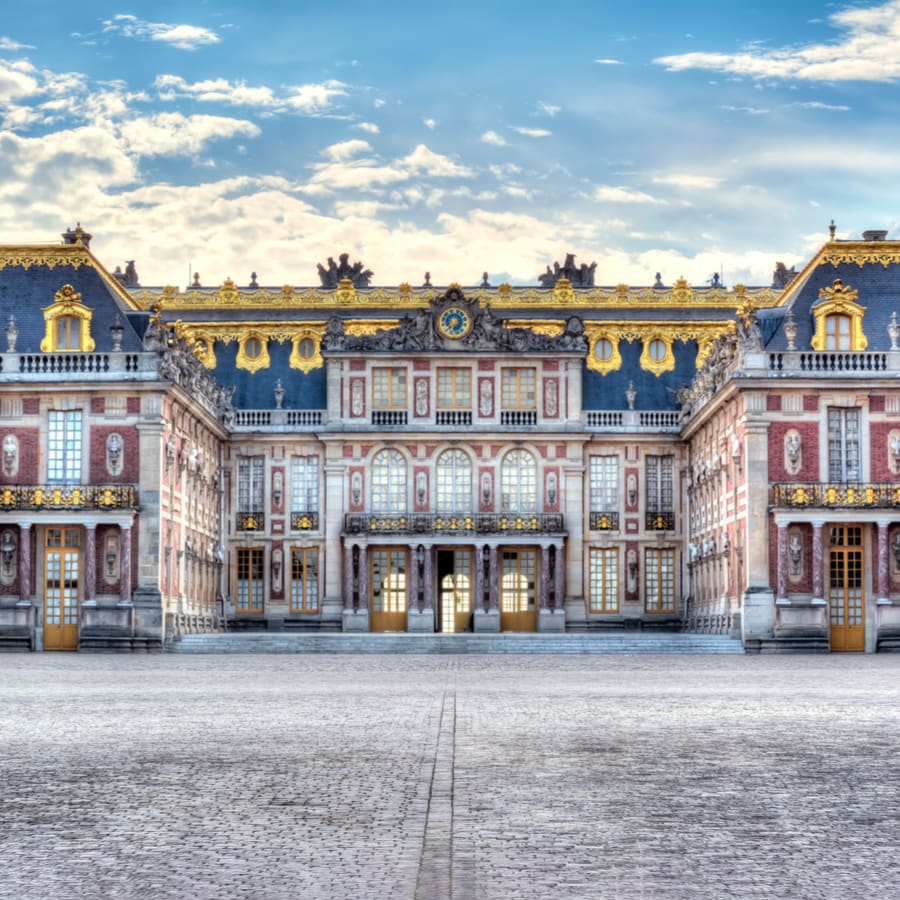
Day 4
Paris
View More
Day 4
Paris


Early Morning to Afternoon
Grand & Grand Gardeners, Visiting the Palace of Versailles
The Château of Versailles, a symbol of the grandeur of French monarchy, invites visitors to explore its lavish history and architectural majesty. From the spellbinding elegance of the Hall of Mirrors, where the Treaty of Versailles was signed, to the vast, meticulously manicured Gardens the pinnacle of French garden design, every corner tells a story of opulence and power. Discover the intimate escapes of royalty at the Grand and Petit Trianon, and marvel at the divine beauty of the Royal Chapel, a masterpiece of Baroque architecture.

The Queen's Hamlet
Imagine living like the "peasants" here?
Show More

Parc de Versailles
Feel like a king, feel like a queen, hopefully you'll feel good looking out across the park
Show More

Main Palace of Versailles
There are palaces, and then there is Versailles...
Show More

The Queen's Hamlet
Imagine living like the "peasants" here?
Show More

Parc de Versailles
Feel like a king, feel like a queen, hopefully you'll feel good looking out across the park
Show More

Main Palace of Versailles
There are palaces, and then there is Versailles...
Show More

The Queen's Hamlet
Imagine living like the "peasants" here?
Show More
prev
next

Day 4
Paris
View More

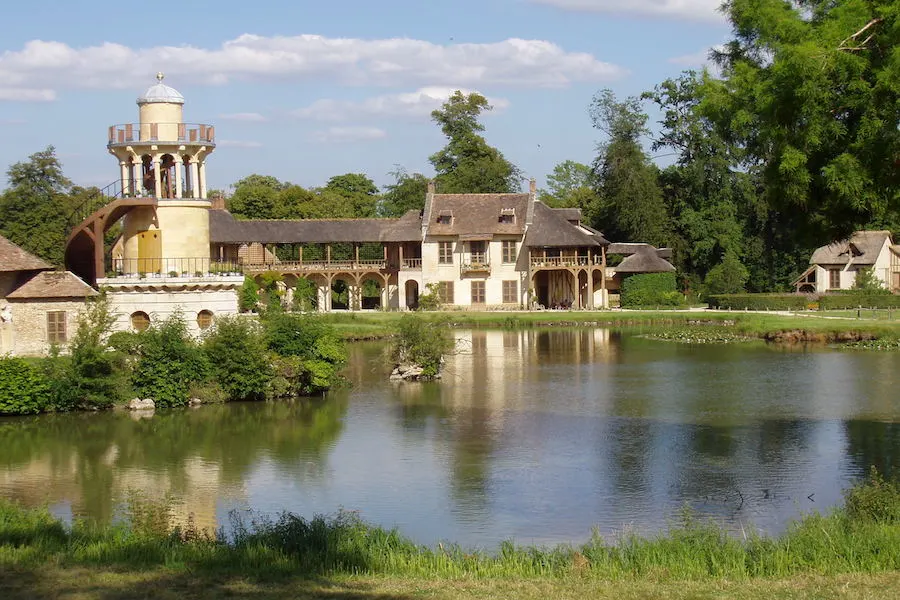
The Queen's Hamlet
 Highlight of Palace of Versailles
Highlight of Palace of VersaillesImagine living like the "peasants" here?
Desiring something different, Queen Marie Antoinette had a hamlet erected where she could supervise servants milking cows, tending pigs, collecting eggs from chickens. She dressed down to play her part, but apparently never got her hands dirty, as far as we know. Her peasant cottage only had two living rooms, a billiard room, a dining hall, and a library. If you are accustomed to palaces, only two living rooms is roughing it. Lest the queen got tired of it all, she could return to the Petit Trianon, a beautiful chateau built on the grounds of the Grand Trianon, which was the retreat chateau built on the grounds of the Palace of Versailles, which was a retreat from the Louvre Palace in Paris.
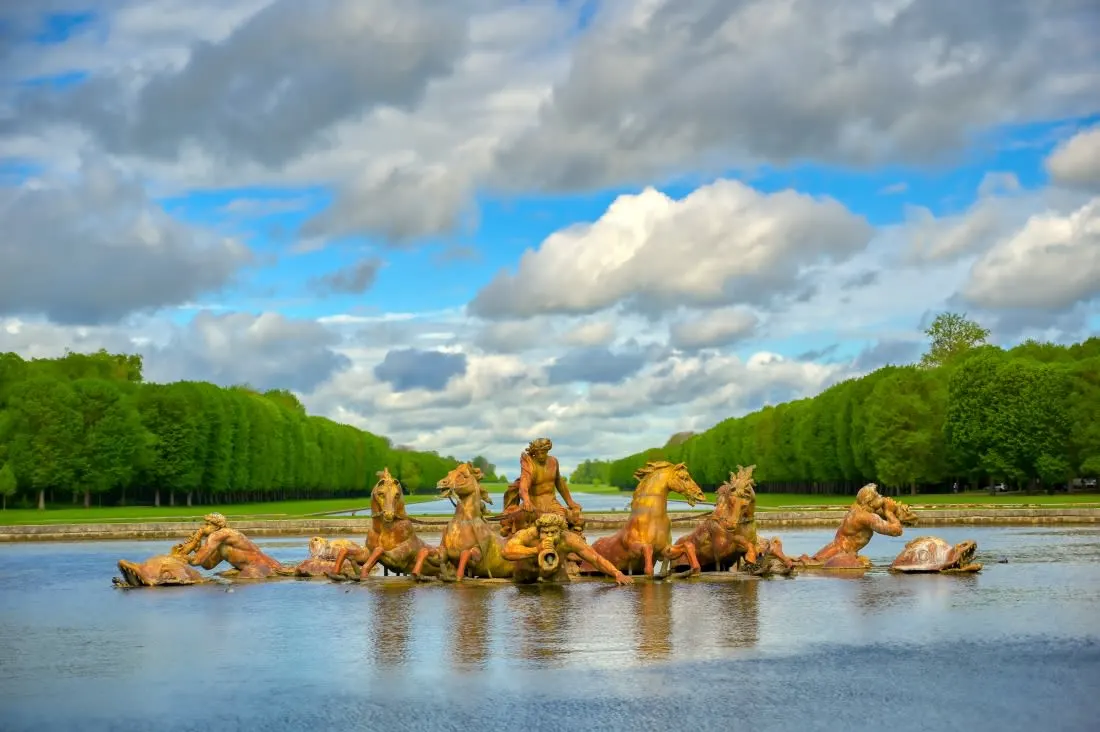
Parc de Versailles
 Highlight of Palace of Versailles
Highlight of Palace of VersaillesFeel like a king, feel like a queen, hopefully you'll feel good looking out across the park
The Parc de Versailles, features some 800 hectares of manicured lawns, stunning fountains, and the Grand Canal, all masterminded by André Le Nôtre. Highlights include the Neptune and Apollo Fountains, the Trianon Palaces, and the Queen's Hamlet. This vast garden symbolizes royal power, but you are welcomed to enjoy yourself on these pleasure grounds.
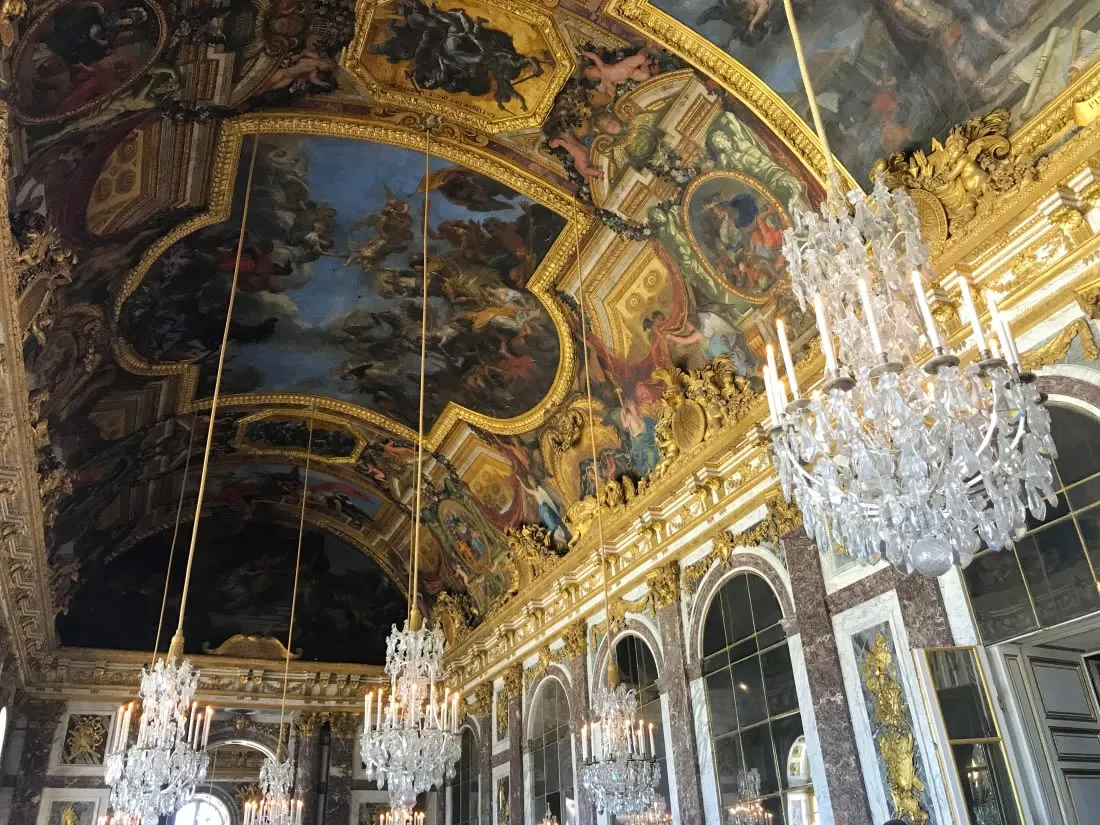
Main Palace of Versailles
 Highlight of Palace of Versailles
Highlight of Palace of VersaillesThere are palaces, and then there is Versailles...
Enlarged by for Emperor Louis XIV as an escape from the dreary political tension of Paris, Versailles might have been the most luxurious palace in the world. Even now, the building stuptifies with its grandeur and elegance, a stunning representation of the French monarchy's opulence. The famous Hall of Mirrors is just one of many, many (2300!) stunning rooms, only a small percentage of which are open for display. It might be too much, or one visit might never be enough.

The Queen's Hamlet
 Highlight of Palace of Versailles
Highlight of Palace of VersaillesImagine living like the "peasants" here?
Desiring something different, Queen Marie Antoinette had a hamlet erected where she could supervise servants milking cows, tending pigs, collecting eggs from chickens. She dressed down to play her part, but apparently never got her hands dirty, as far as we know. Her peasant cottage only had two living rooms, a billiard room, a dining hall, and a library. If you are accustomed to palaces, only two living rooms is roughing it. Lest the queen got tired of it all, she could return to the Petit Trianon, a beautiful chateau built on the grounds of the Grand Trianon, which was the retreat chateau built on the grounds of the Palace of Versailles, which was a retreat from the Louvre Palace in Paris.

Parc de Versailles
 Highlight of Palace of Versailles
Highlight of Palace of VersaillesFeel like a king, feel like a queen, hopefully you'll feel good looking out across the park
The Parc de Versailles, features some 800 hectares of manicured lawns, stunning fountains, and the Grand Canal, all masterminded by André Le Nôtre. Highlights include the Neptune and Apollo Fountains, the Trianon Palaces, and the Queen's Hamlet. This vast garden symbolizes royal power, but you are welcomed to enjoy yourself on these pleasure grounds.

Main Palace of Versailles
 Highlight of Palace of Versailles
Highlight of Palace of VersaillesThere are palaces, and then there is Versailles...
Enlarged by for Emperor Louis XIV as an escape from the dreary political tension of Paris, Versailles might have been the most luxurious palace in the world. Even now, the building stuptifies with its grandeur and elegance, a stunning representation of the French monarchy's opulence. The famous Hall of Mirrors is just one of many, many (2300!) stunning rooms, only a small percentage of which are open for display. It might be too much, or one visit might never be enough.

The Queen's Hamlet
 Highlight of Palace of Versailles
Highlight of Palace of VersaillesImagine living like the "peasants" here?
Desiring something different, Queen Marie Antoinette had a hamlet erected where she could supervise servants milking cows, tending pigs, collecting eggs from chickens. She dressed down to play her part, but apparently never got her hands dirty, as far as we know. Her peasant cottage only had two living rooms, a billiard room, a dining hall, and a library. If you are accustomed to palaces, only two living rooms is roughing it. Lest the queen got tired of it all, she could return to the Petit Trianon, a beautiful chateau built on the grounds of the Grand Trianon, which was the retreat chateau built on the grounds of the Palace of Versailles, which was a retreat from the Louvre Palace in Paris.
prev
next

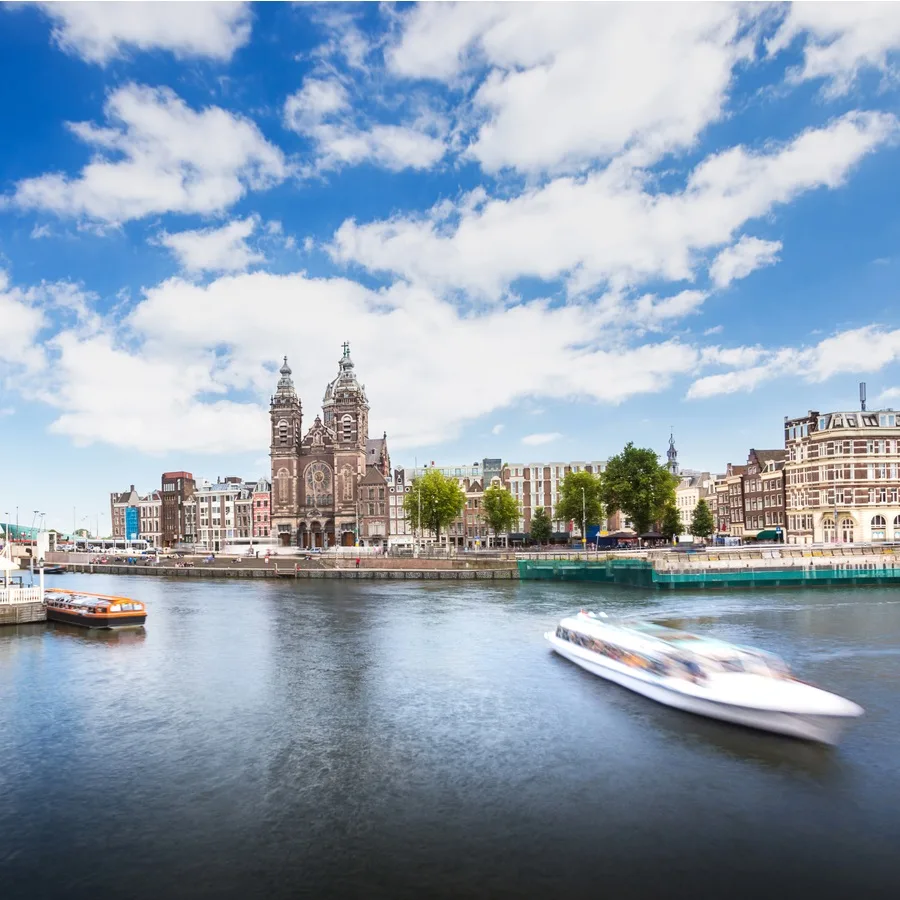
Day 5
Paris to Amsterdam
View More
Day 5
Paris to Amsterdam






To Be Determined
Rail Drop-Off by Taxi
Paris taxis are generally reliable and honest, so this is cheaper than a pre-arranged transfer. Parisian streets can get very congested, but if you are picked up one hour and 15 minutes prior to departure, you should have plenty of time to catch your train. Instructions for calling a taxi and finding your way around your specific rail station are included in the Full Itinerary.

Day 5
Paris to Amsterdam
View More


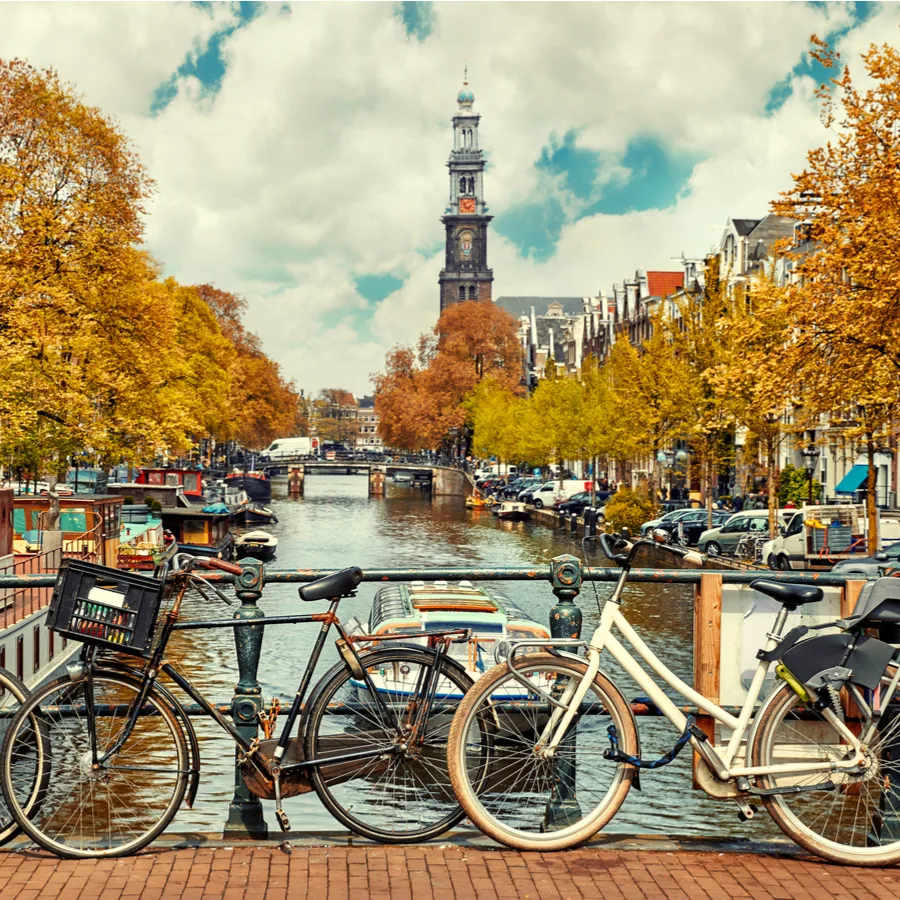
Day 6
Amsterdam
View More
Day 6
Amsterdam



9:30 AM - 12:30 PM
Privately Guided Walking Tour of Amsterdam
Make your introductions to Amsterdam with this 3-hour privately-guided walking tour. After picking you up from your hotel, your professional guide will lead you past many of the greatest highlights of the city, including its center, as well as the Jordaan, the Grachtengordel, and the infamous Red-Light District. The guide will explain how all these feature in the citiy's history and contemporary life. Your guide will be happy to share some great tips for the rest of your stay.

Day 6
Amsterdam
View More


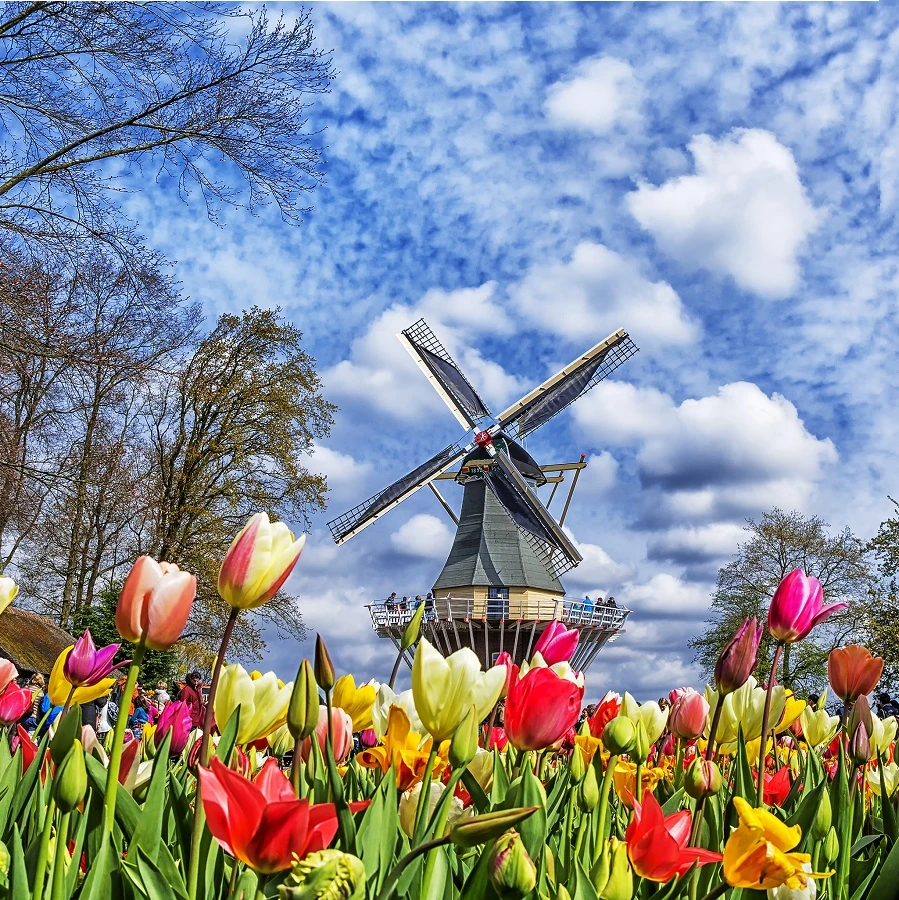
Day 7
Amsterdam
View More
Day 7
Amsterdam



Morning
Self-Guided Excursion to Keukenhof Gardens
Keukenhof is an impressively large flower garden boasting up to seven million flowers. It's one of the greatest lasting legacies of the tulip mania that gripped in the Netherlands in the late 16th century after a Dutch botanist brought back a tulip bulb from Turkey via Vienna and discovered that the country's sandy soils were the perfect environment for the flower. The frenzied interest in the plant led to the world's first recorded financial bubble, whose inevitable collapse led to the loss of huge speculative fortunes. Each spring, the Keukenhof Gardens in Lisse come alive with blooming flowers in every color of the rainbow. Come tip-toe through the tulips at the world’s largest flower gardens.

Day 7
Amsterdam
View More


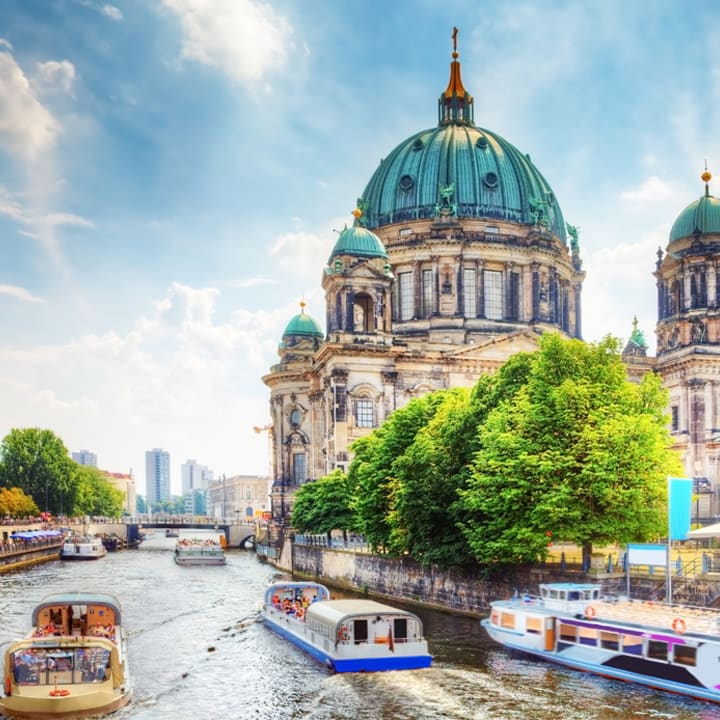
Day 8
Amsterdam to Berlin
View More
Day 8
Amsterdam to Berlin




10:55 AM
Transfer to Station by Taxi or Public Transport
Most trains depart from Amsterdam Central Station (Centraal) station, the largest station in the city. Before spending money on a transfer, be sure to check whether your hotel is within easy walking distance. Also consider that public transport is the cheapest and sometimes fastest option. Trams and the metro deliver you to the main entrance of the station. If staying at a hotel, they can order a reliable taxi. Uber is also available for those with the app. There is not such convenient access by car to the Central Station, but your taxi driver will nonetheless be able to drop you off on the lakeside side of the station. To get to the platforms you need to swipe the bar code on your train ticket on the small screen on the automatic gates. The main entry tunnel, as well as two other tunnels, lead you to the station platforms.

Day 8
Amsterdam to Berlin
View More


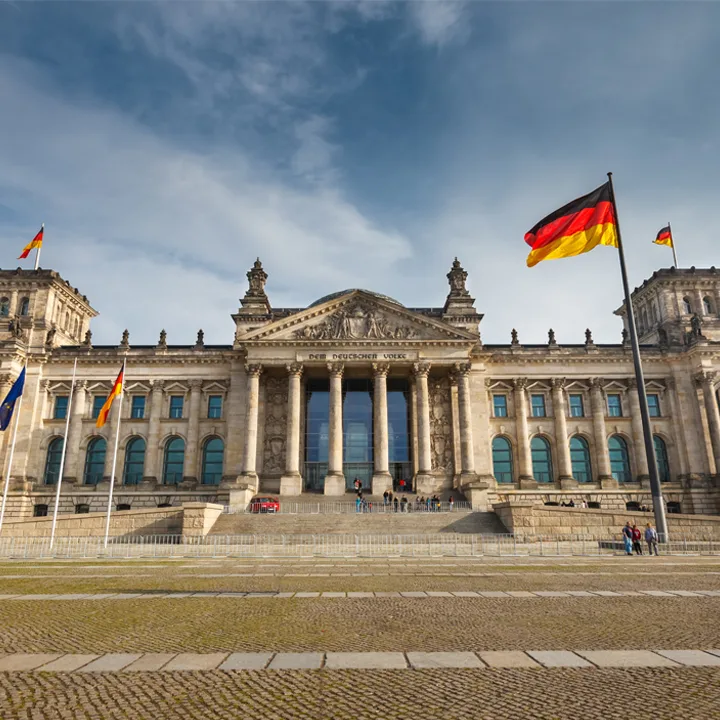
Day 9
Berlin
View More
Day 9
Berlin



9:00 AM - 12:00 PM
Highlights of Berlin Guided Walking Tour
On this 3 hour tour, your guide will show you the highlights of Berlin and help you understand what makes this city so unique. Sites visited will include the boulevard Unter den Linden, the Gendarmenmarkt, Check Point Charlie, remnants of the Berlin Wall, Potsdamer Platz, the Holocaust Memorial, the Brandenburg Gate, and the Reichstag.

Brandenburg Gate
Quadriga. Hey, There's a Word to Know When Learning About this Historic Gate
Show More

Reichstag
Make your way to the top of the dome enjoying amazing views and looking down at debating members of the German Parliament below.
Show More

Brandenburg Gate
Quadriga. Hey, There's a Word to Know When Learning About this Historic Gate
Show More

Reichstag
Make your way to the top of the dome enjoying amazing views and looking down at debating members of the German Parliament below.
Show More

Brandenburg Gate
Quadriga. Hey, There's a Word to Know When Learning About this Historic Gate
Show More

Reichstag
Make your way to the top of the dome enjoying amazing views and looking down at debating members of the German Parliament below.
Show More
prev
next

Day 9
Berlin
View More

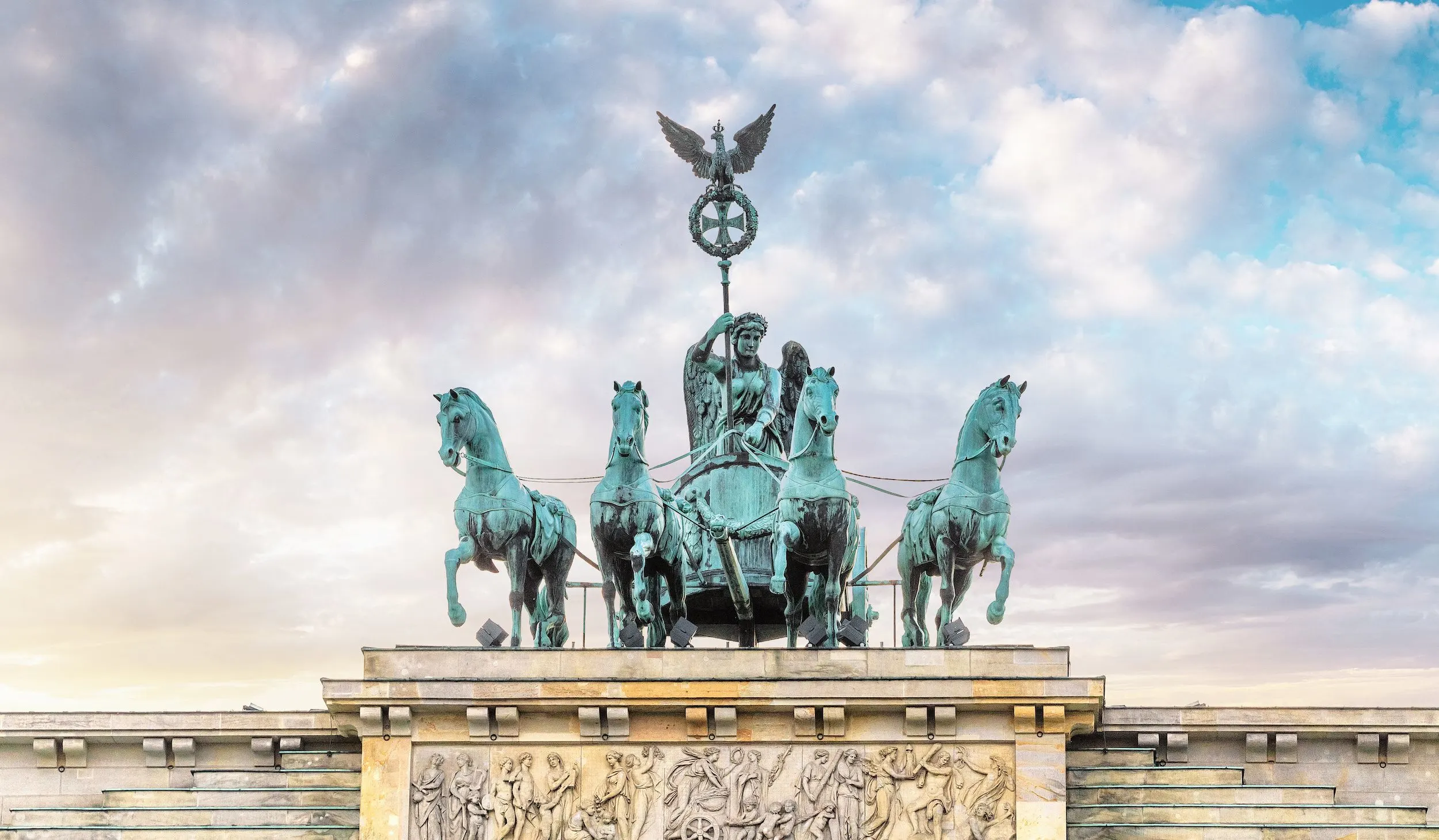
Brandenburg Gate
 Highlight of Guided Walking Tour of Berlin
Highlight of Guided Walking Tour of BerlinQuadriga. Hey, There's a Word to Know When Learning About this Historic Gate
The Brandenburg Gate was built as a symbol of peace, perverted into a symbol of power by the Nazis, and became a symbol of division during the Cold War. Now, however, it is a symbol of reunification. Completed in 1791, it was topped by the quadriga, a chariot drawn by four horses driven by the goddess of peace. Napoleon seized the quadriga as a spoil of war, but after his defeat, it was returned to the city and met by cheering crowds along the way, transforming the goddess of peace into a goddess of victory, holding a Germanic cross.
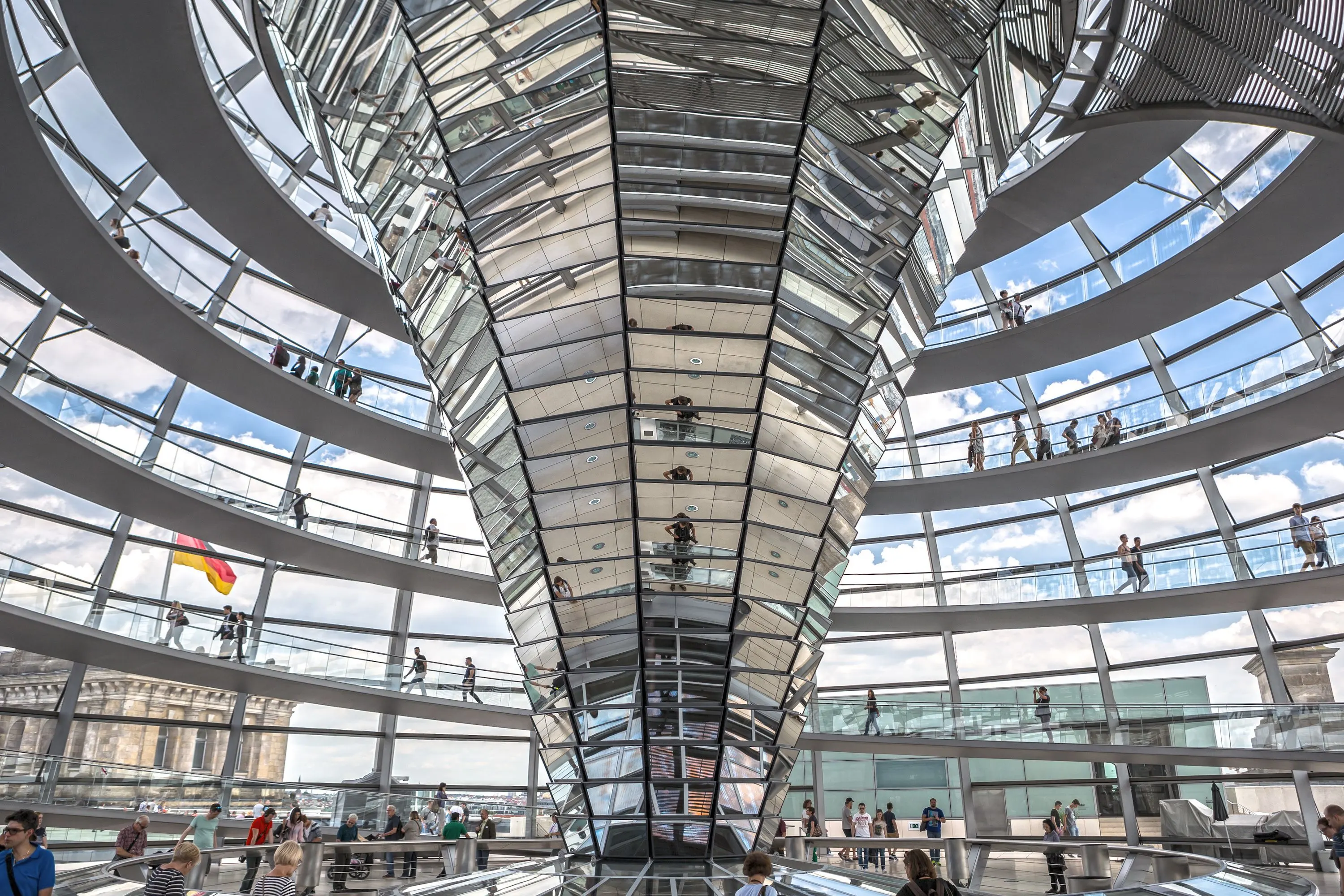
Reichstag
 Highlight of Guided Walking Tour of Berlin
Highlight of Guided Walking Tour of BerlinMake your way to the top of the dome enjoying amazing views and looking down at debating members of the German Parliament below.
Officially, the Reichstag is actually the Bundestag, which means the federal parliament. The Reichstag was reduced to a ruined shell by arson in 1933 and by World War II fighting, but it was rebuilt with a striking egg-shaped glass dome. Visitors are given a free audio guide that discusses the building’s history and architecture, while also orientating you to the sites of Berlin. It is an excellent introduction to the city. Note that it is usually necessary to book well in advance!

Brandenburg Gate
 Highlight of Guided Walking Tour of Berlin
Highlight of Guided Walking Tour of BerlinQuadriga. Hey, There's a Word to Know When Learning About this Historic Gate
The Brandenburg Gate was built as a symbol of peace, perverted into a symbol of power by the Nazis, and became a symbol of division during the Cold War. Now, however, it is a symbol of reunification. Completed in 1791, it was topped by the quadriga, a chariot drawn by four horses driven by the goddess of peace. Napoleon seized the quadriga as a spoil of war, but after his defeat, it was returned to the city and met by cheering crowds along the way, transforming the goddess of peace into a goddess of victory, holding a Germanic cross.

Reichstag
 Highlight of Guided Walking Tour of Berlin
Highlight of Guided Walking Tour of BerlinMake your way to the top of the dome enjoying amazing views and looking down at debating members of the German Parliament below.
Officially, the Reichstag is actually the Bundestag, which means the federal parliament. The Reichstag was reduced to a ruined shell by arson in 1933 and by World War II fighting, but it was rebuilt with a striking egg-shaped glass dome. Visitors are given a free audio guide that discusses the building’s history and architecture, while also orientating you to the sites of Berlin. It is an excellent introduction to the city. Note that it is usually necessary to book well in advance!

Brandenburg Gate
 Highlight of Guided Walking Tour of Berlin
Highlight of Guided Walking Tour of BerlinQuadriga. Hey, There's a Word to Know When Learning About this Historic Gate
The Brandenburg Gate was built as a symbol of peace, perverted into a symbol of power by the Nazis, and became a symbol of division during the Cold War. Now, however, it is a symbol of reunification. Completed in 1791, it was topped by the quadriga, a chariot drawn by four horses driven by the goddess of peace. Napoleon seized the quadriga as a spoil of war, but after his defeat, it was returned to the city and met by cheering crowds along the way, transforming the goddess of peace into a goddess of victory, holding a Germanic cross.

Reichstag
 Highlight of Guided Walking Tour of Berlin
Highlight of Guided Walking Tour of BerlinMake your way to the top of the dome enjoying amazing views and looking down at debating members of the German Parliament below.
Officially, the Reichstag is actually the Bundestag, which means the federal parliament. The Reichstag was reduced to a ruined shell by arson in 1933 and by World War II fighting, but it was rebuilt with a striking egg-shaped glass dome. Visitors are given a free audio guide that discusses the building’s history and architecture, while also orientating you to the sites of Berlin. It is an excellent introduction to the city. Note that it is usually necessary to book well in advance!
prev
next


Day 10
Berlin
View More
Day 10
Berlin



Morning/Mid-Day
Explore the Museum Island
This island in the River Spree is home to five world-renowned museums, which could easily fill up a whole trip just by themselves. The island is covered in trees and green lawns, while the classically-inspired architecture of the museums can be enjoyed without even stepping inside. Unfortunately, the biggest star of the island, the Pergamon Museum, with its wholly reconstructed ancient buildings, is closed until 2026 for renovations. However, you can still visit a massive 360-panorama depicting the ancient city of Pergamon, and there's still more museums to visit than you could possibly fit in. Also to be found on and around Museum Island are the majestic Berliner Dom cathedral and the huge Berlin Palace.

Neues Museum
Stare into the eyes of the famed Egyptian queen Nefertiti and see other ancient artwork and archeological artifacts.
Show More

Berliner Dom
Climb 270 steps to the top of this massive 19th century cathedral for a unique panoramic view of the city.
Show More

Pergamonmuseum
Relive the past in one of the world's premier museums of archealogy and ancient art. You can step into enormous ancient structures, wholly reconstructed.
Show More

Neues Museum
Stare into the eyes of the famed Egyptian queen Nefertiti and see other ancient artwork and archeological artifacts.
Show More

Berliner Dom
Climb 270 steps to the top of this massive 19th century cathedral for a unique panoramic view of the city.
Show More

Pergamonmuseum
Relive the past in one of the world's premier museums of archealogy and ancient art. You can step into enormous ancient structures, wholly reconstructed.
Show More

Neues Museum
Stare into the eyes of the famed Egyptian queen Nefertiti and see other ancient artwork and archeological artifacts.
Show More
prev
next

Day 10
Berlin
View More

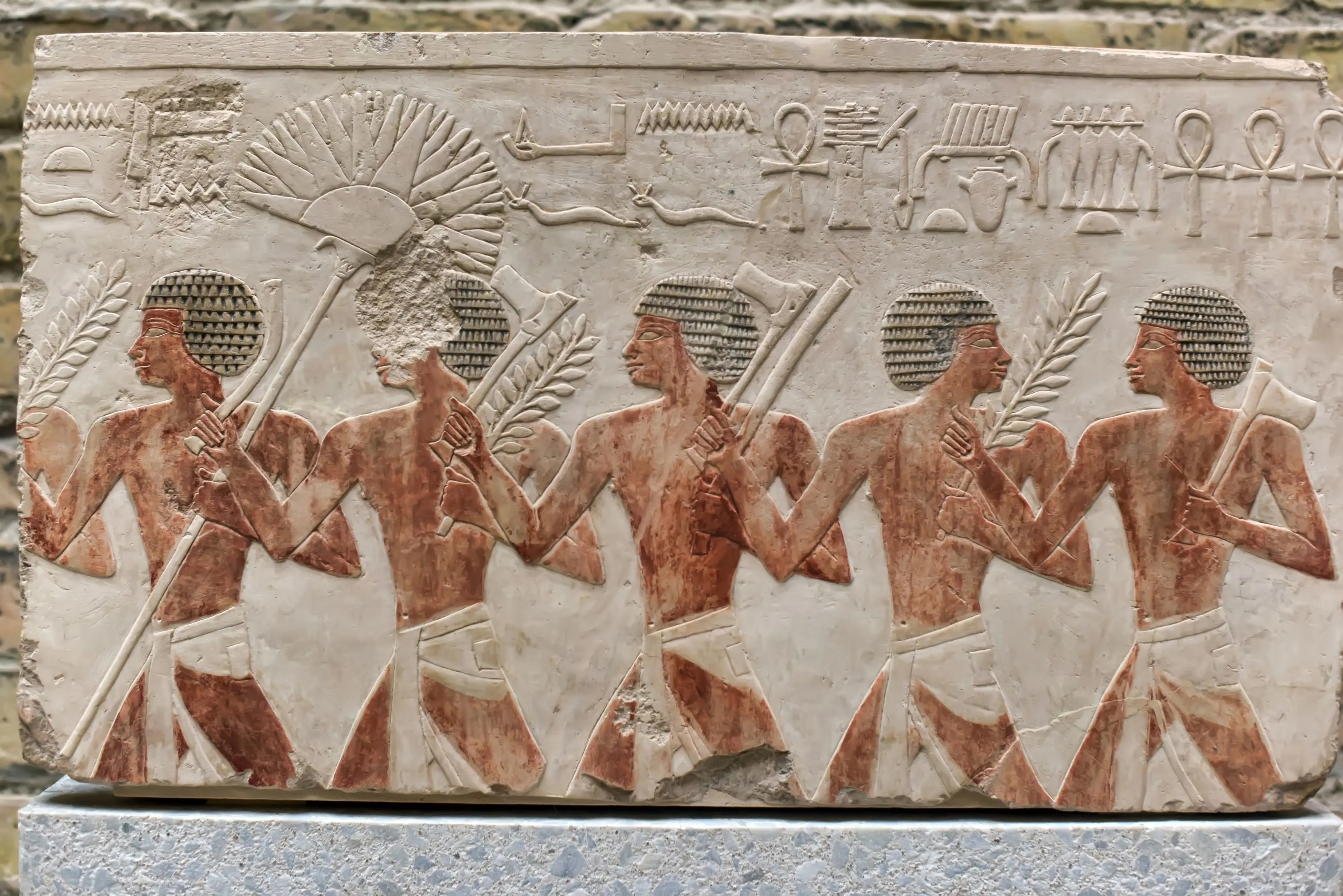
Neues Museum
 Highlight of Museum Island
Highlight of Museum IslandStare into the eyes of the famed Egyptian queen Nefertiti and see other ancient artwork and archeological artifacts.
The New Museum was opened in 1859 to relieve pressure on the over-crowded Old Museum. The three exhibition floors were decorated by leading Classical painters, with a focal point being a grand staircase winding up all three stories. Exhibits include the archaeological collections of the Egyptian Museum and Papyrus Collection, the Museum of Pre- and Early History, and the Collection of Classical Antiquities. The 3300-year-old bust of Egyptian Queen Nefertiti is the showstopper.

Berliner Dom
 Highlight of Museum Island
Highlight of Museum IslandClimb 270 steps to the top of this massive 19th century cathedral for a unique panoramic view of the city.
Berlin Cathedral, nestled on Museum Island, epitomizes German neo-Renaissance grandeur with its striking dome. Built from 1894 to 1905 and restored post-World War II, its lavish interior, stained glass, and notable pipe organ draw visitors. Beyond a place of worship, it houses the former imperial ruling family's, the Hohenzollern, crypt, revealing the dynastic past of Germany.
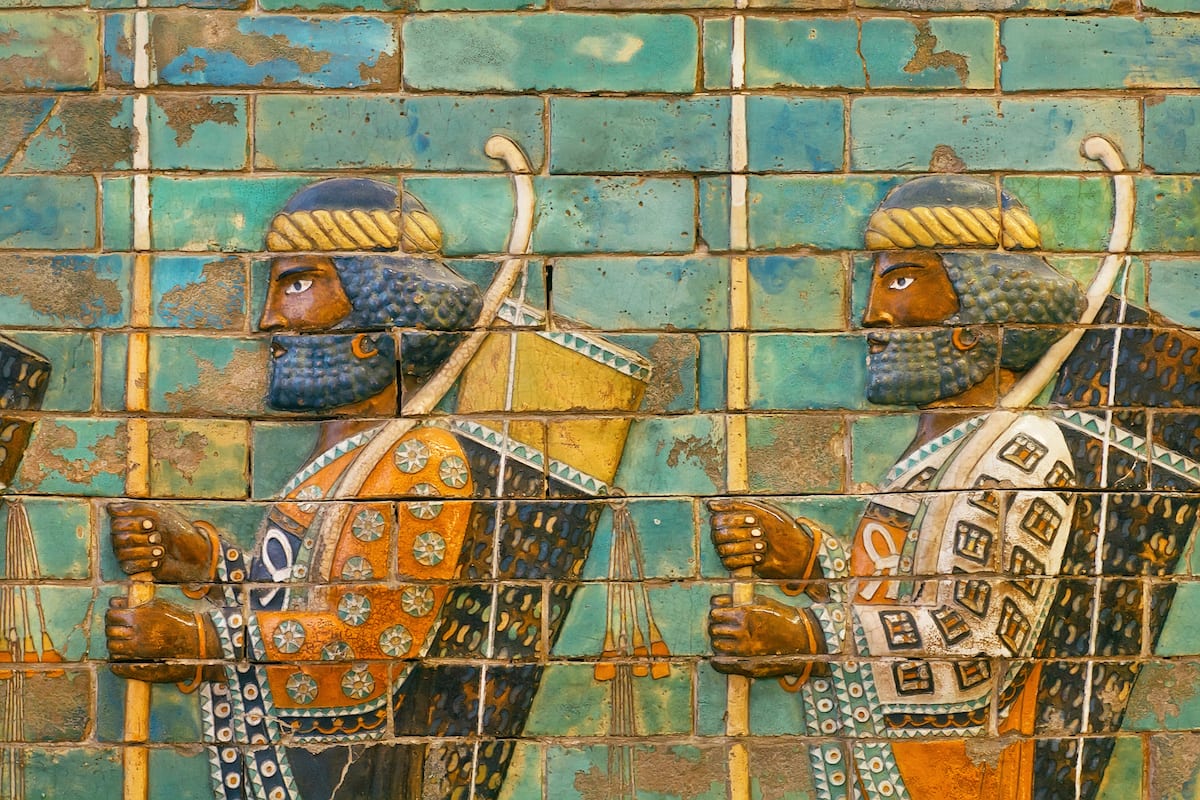
Pergamonmuseum
 Highlight of Museum Island
Highlight of Museum IslandRelive the past in one of the world's premier museums of archealogy and ancient art. You can step into enormous ancient structures, wholly reconstructed.
The museum is a jaw-dropping feast of classical sculpture and monumental architecture from Greece, Rome, Babylon and the Middle East divided into three parts. Highlights include the radiant-blue Ishtar Gate from Babylon, the Roman Market Gate of Miletus and the Caliph's Palace of Mshatta.

Neues Museum
 Highlight of Museum Island
Highlight of Museum IslandStare into the eyes of the famed Egyptian queen Nefertiti and see other ancient artwork and archeological artifacts.
The New Museum was opened in 1859 to relieve pressure on the over-crowded Old Museum. The three exhibition floors were decorated by leading Classical painters, with a focal point being a grand staircase winding up all three stories. Exhibits include the archaeological collections of the Egyptian Museum and Papyrus Collection, the Museum of Pre- and Early History, and the Collection of Classical Antiquities. The 3300-year-old bust of Egyptian Queen Nefertiti is the showstopper.

Berliner Dom
 Highlight of Museum Island
Highlight of Museum IslandClimb 270 steps to the top of this massive 19th century cathedral for a unique panoramic view of the city.
Berlin Cathedral, nestled on Museum Island, epitomizes German neo-Renaissance grandeur with its striking dome. Built from 1894 to 1905 and restored post-World War II, its lavish interior, stained glass, and notable pipe organ draw visitors. Beyond a place of worship, it houses the former imperial ruling family's, the Hohenzollern, crypt, revealing the dynastic past of Germany.

Pergamonmuseum
 Highlight of Museum Island
Highlight of Museum IslandRelive the past in one of the world's premier museums of archealogy and ancient art. You can step into enormous ancient structures, wholly reconstructed.
The museum is a jaw-dropping feast of classical sculpture and monumental architecture from Greece, Rome, Babylon and the Middle East divided into three parts. Highlights include the radiant-blue Ishtar Gate from Babylon, the Roman Market Gate of Miletus and the Caliph's Palace of Mshatta.

Neues Museum
 Highlight of Museum Island
Highlight of Museum IslandStare into the eyes of the famed Egyptian queen Nefertiti and see other ancient artwork and archeological artifacts.
The New Museum was opened in 1859 to relieve pressure on the over-crowded Old Museum. The three exhibition floors were decorated by leading Classical painters, with a focal point being a grand staircase winding up all three stories. Exhibits include the archaeological collections of the Egyptian Museum and Papyrus Collection, the Museum of Pre- and Early History, and the Collection of Classical Antiquities. The 3300-year-old bust of Egyptian Queen Nefertiti is the showstopper.
prev
next

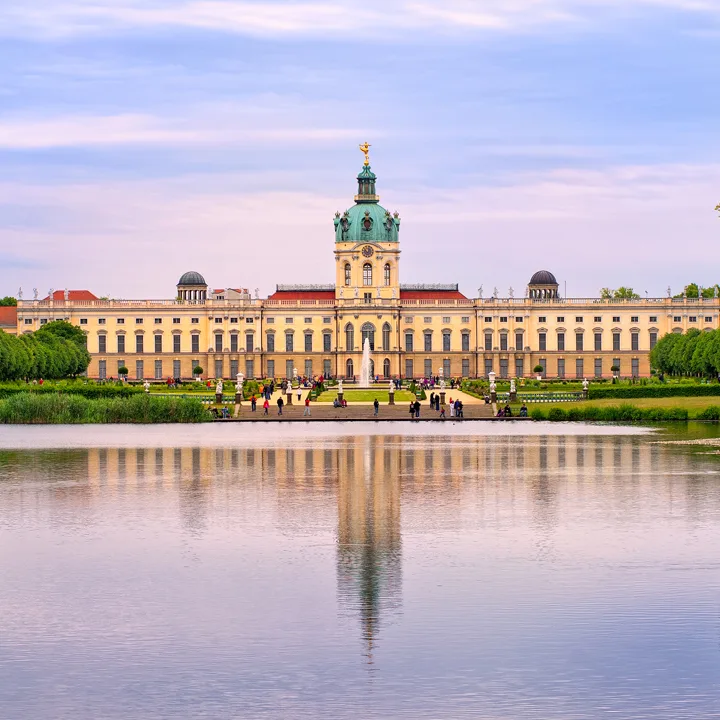
Day 11
Berlin to Prague
View More
Day 11
Berlin to Prague





Early Morning to Mid-Day
Tour the Charlottenburg Palace and Gardens
Despite its many historic buildings, Berlin's modern architecture, constant construction, and hipness often make it feel like a thoroughly 21st century city. It is nice, therefore, to escape the bustle of the city by visiting the beautiful palace of Charlottenburg and its idyllic park and gardens. Constructed in 1696, the palace was nearly completely destroyed in World War II, but was lovingly restored to its baroque grandeur.

Museum Berggruen
Check out some Picasso paintings in this museum located on the tree-lined boulevard just opposite the palace entrance.
Show More

Charlottenburg Palace Park
Get pleasantly lost in the royal park surrounding the palace.
Show More

Charlottenburg Palace
Discover that German design isn't always sleek and efficient in this beautiful baroque palace built with its beautiful collections of art and furnishings.
Show More

Museum Berggruen
Check out some Picasso paintings in this museum located on the tree-lined boulevard just opposite the palace entrance.
Show More

Charlottenburg Palace Park
Get pleasantly lost in the royal park surrounding the palace.
Show More

Charlottenburg Palace
Discover that German design isn't always sleek and efficient in this beautiful baroque palace built with its beautiful collections of art and furnishings.
Show More

Museum Berggruen
Check out some Picasso paintings in this museum located on the tree-lined boulevard just opposite the palace entrance.
Show More
prev
next

Day 11
Berlin to Prague
View More

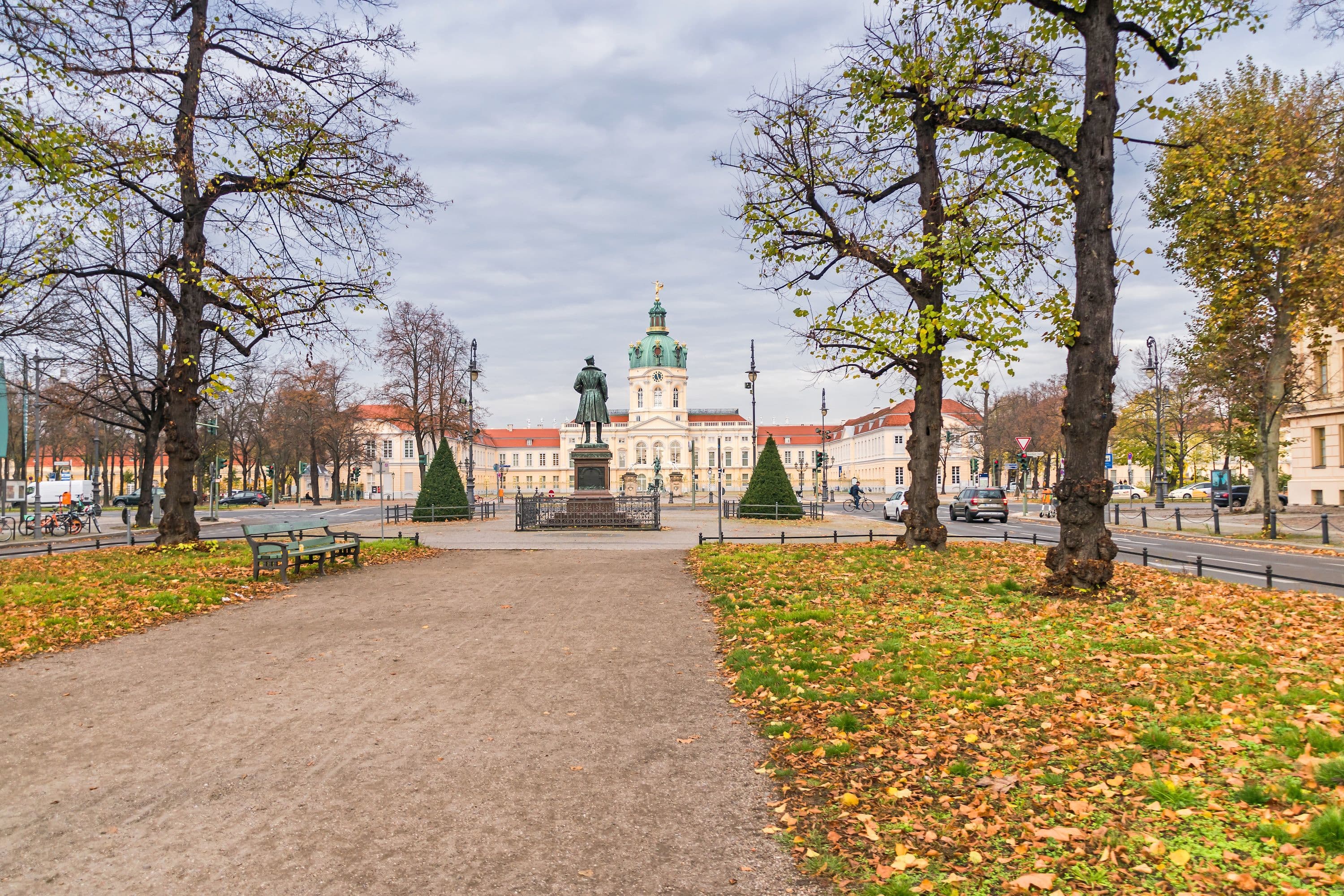
Museum Berggruen
 Highlight of Charlottenburg Palace
Highlight of Charlottenburg PalaceCheck out some Picasso paintings in this museum located on the tree-lined boulevard just opposite the palace entrance.
The musem holds a collection of rarely seen Picasso paintings, as well as other notable artwork, including some Cezannes, van Goghs and Klees. There are several other worthwhile museums, as well as cafes and beautiful villas all located nearby on the street known as Schloßtraße.
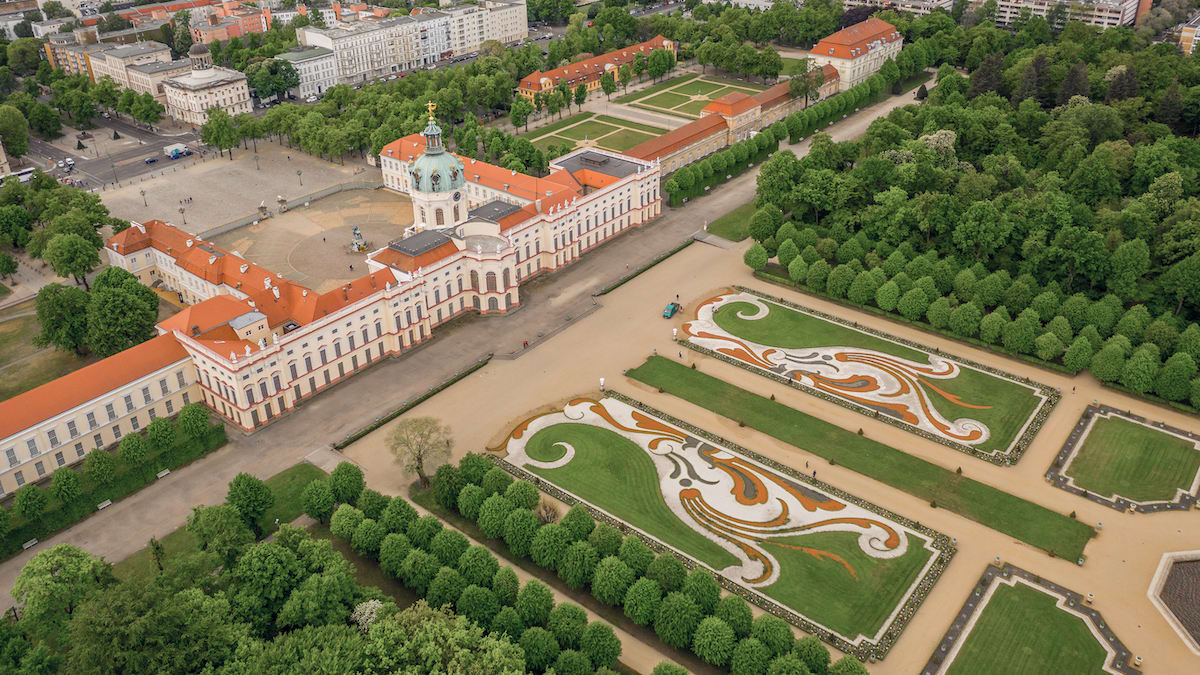
Charlottenburg Palace Park
 Highlight of Charlottenburg Palace
Highlight of Charlottenburg PalaceGet pleasantly lost in the royal park surrounding the palace.
The elegant formal Baroque garden directly adjacent to the palace has been restored to its original layout from the 1700's, complete with ornate fountains featuring replica antique sculptures. Beyond the gardens, you will find a delightfully relaxing forested park, which is criss-crossed by gravel paths and interspersed with canals and other waterways. It is a delight to explore either on foot or bicycle.
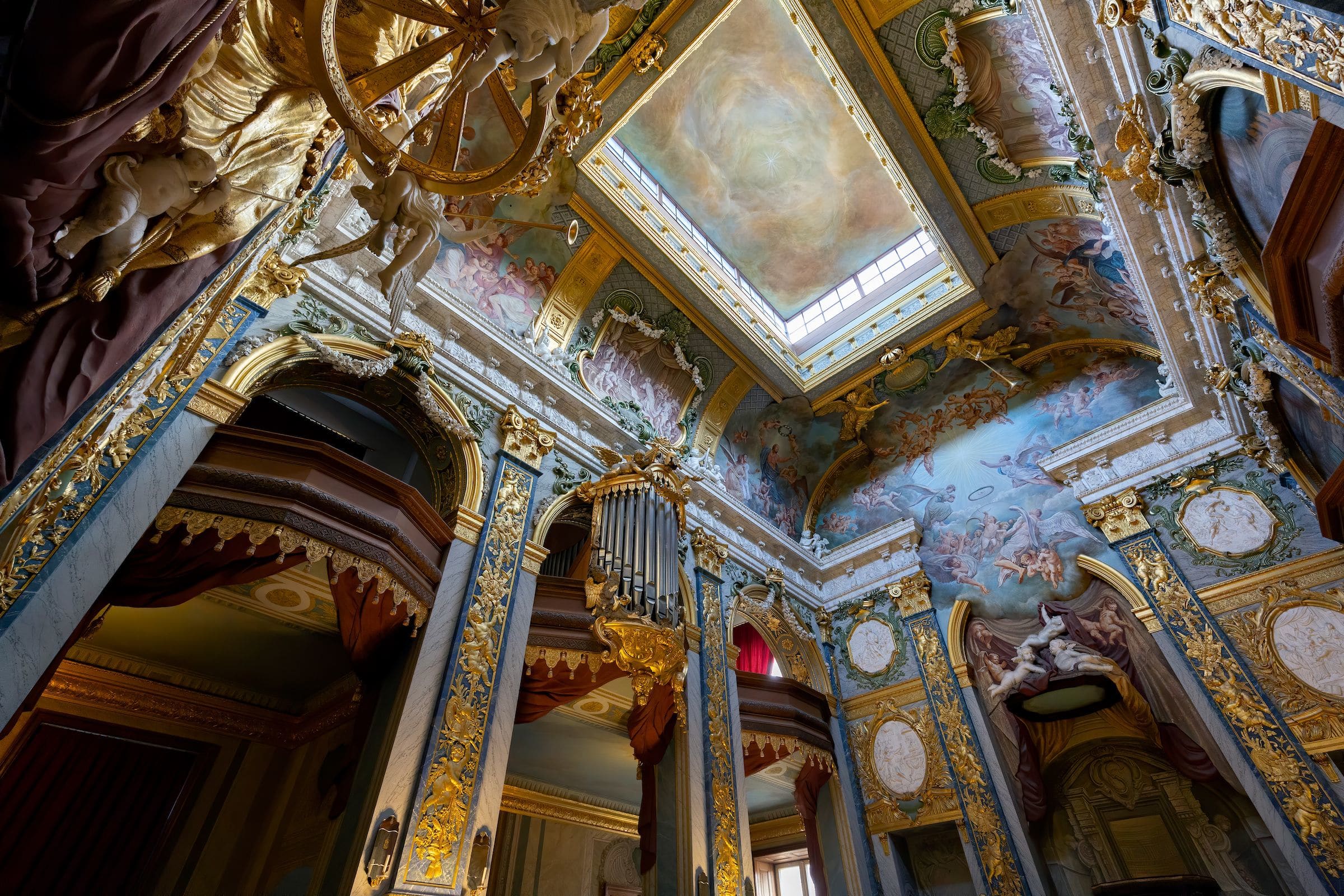
Charlottenburg Palace
 Highlight of Charlottenburg Palace
Highlight of Charlottenburg PalaceDiscover that German design isn't always sleek and efficient in this beautiful baroque palace built with its beautiful collections of art and furnishings.
Originally a modest summer retreat, it grew into an exquisite baroque edifice with opulent private apartments, richly festooned festival halls, collections of precious porcelain and paintings by French 18th-century masters. Especially fascinating is the Porzellankabinett, a room with walls lined from top to bottom by fine Japanese and Chinese porcelain.

Museum Berggruen
 Highlight of Charlottenburg Palace
Highlight of Charlottenburg PalaceCheck out some Picasso paintings in this museum located on the tree-lined boulevard just opposite the palace entrance.
The musem holds a collection of rarely seen Picasso paintings, as well as other notable artwork, including some Cezannes, van Goghs and Klees. There are several other worthwhile museums, as well as cafes and beautiful villas all located nearby on the street known as Schloßtraße.

Charlottenburg Palace Park
 Highlight of Charlottenburg Palace
Highlight of Charlottenburg PalaceGet pleasantly lost in the royal park surrounding the palace.
The elegant formal Baroque garden directly adjacent to the palace has been restored to its original layout from the 1700's, complete with ornate fountains featuring replica antique sculptures. Beyond the gardens, you will find a delightfully relaxing forested park, which is criss-crossed by gravel paths and interspersed with canals and other waterways. It is a delight to explore either on foot or bicycle.

Charlottenburg Palace
 Highlight of Charlottenburg Palace
Highlight of Charlottenburg PalaceDiscover that German design isn't always sleek and efficient in this beautiful baroque palace built with its beautiful collections of art and furnishings.
Originally a modest summer retreat, it grew into an exquisite baroque edifice with opulent private apartments, richly festooned festival halls, collections of precious porcelain and paintings by French 18th-century masters. Especially fascinating is the Porzellankabinett, a room with walls lined from top to bottom by fine Japanese and Chinese porcelain.

Museum Berggruen
 Highlight of Charlottenburg Palace
Highlight of Charlottenburg PalaceCheck out some Picasso paintings in this museum located on the tree-lined boulevard just opposite the palace entrance.
The musem holds a collection of rarely seen Picasso paintings, as well as other notable artwork, including some Cezannes, van Goghs and Klees. There are several other worthwhile museums, as well as cafes and beautiful villas all located nearby on the street known as Schloßtraße.
prev
next


Day 12
Prague
View More
Day 12
Prague



9:30 AM - 12:30 PM
Prague Castle & Royal Route Guided Walk
On this charming guided walk, you will explore the Prague Castle, the largest castle complex in all of Europe. To reach the castle you will trace the Royal Coronation Route and cross the Charles Bridge, whose “speaking stones” reveal the amazing and often cruel history that occurred there. Your tour guide will then take you either through the castle courtyards and into the dramatic St. Vitus Cathedral in the center of the castle complex, or through the upper part of the castle district around the oversized palaces of the old Catholic nobility and the top of the Castle Steps for incomparable views over the red rooftops of the Little Quarter.

Charles Bridge
Cross the river dividing Prague's most historic neighborhoods, and experience one of Europe's most iconic landmarks.
Show More

Maltese Square & Lennon Wall
See a historic wall that has been covered in John Lennon-inspired graffiti since Communist days.
Show More

Prague Castle
Prague Castle is one of the main attractions in Prague and is also the largest castle complex in the world.
Show More

Charles Bridge
Cross the river dividing Prague's most historic neighborhoods, and experience one of Europe's most iconic landmarks.
Show More

Maltese Square & Lennon Wall
See a historic wall that has been covered in John Lennon-inspired graffiti since Communist days.
Show More

Prague Castle
Prague Castle is one of the main attractions in Prague and is also the largest castle complex in the world.
Show More

Charles Bridge
Cross the river dividing Prague's most historic neighborhoods, and experience one of Europe's most iconic landmarks.
Show More
prev
next

Day 12
Prague
View More

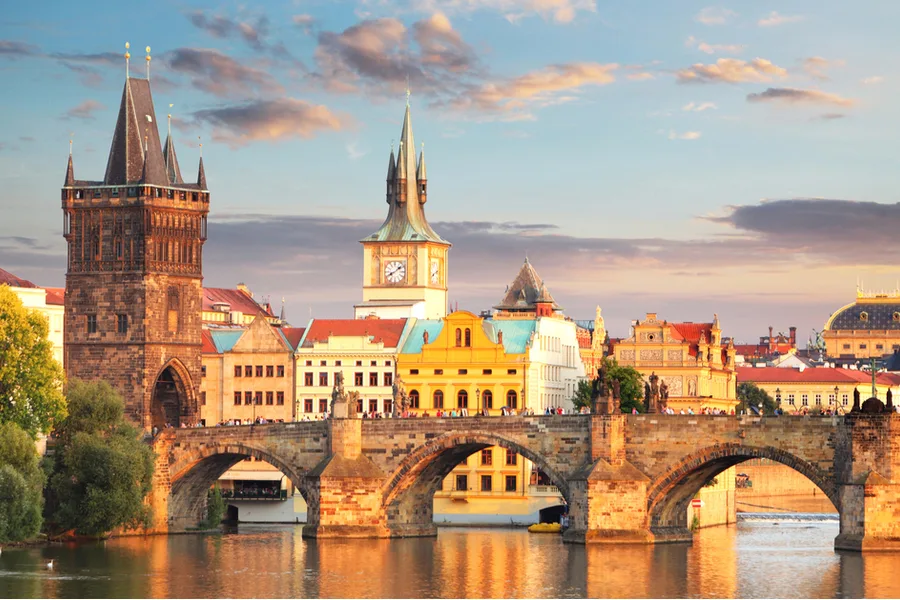
Charles Bridge
 Highlight of Royal Route Guided Tour
Highlight of Royal Route Guided TourCross the river dividing Prague's most historic neighborhoods, and experience one of Europe's most iconic landmarks.
Bridge construction began in 1357 under King Charles IV (hence the name), and it was the only bridge across the Vltava River until 1841. 30 baroque statues of saints line the bridge, and it is filled with street artists and entertainers. Not to be missed.
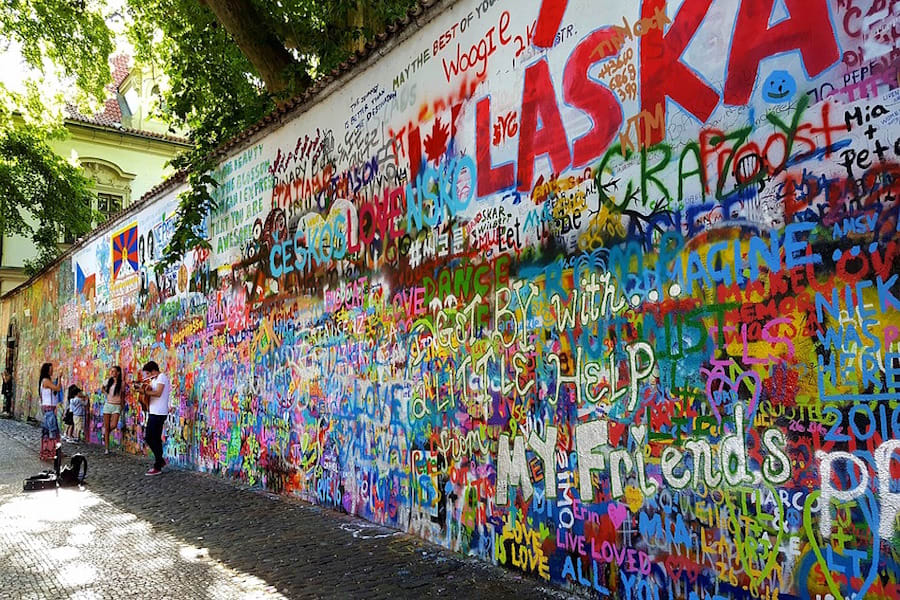
Maltese Square & Lennon Wall
 Highlight of Royal Route Guided Tour
Highlight of Royal Route Guided TourSee a historic wall that has been covered in John Lennon-inspired graffiti since Communist days.
The wall has been covered in graffiti since the 1960s, and during Communism anti-regime sentiment was common. John Lennon's assassination inspired grafitti reflecting his song, Imagine, which earned the wall its current moniker. It is now a favorite gathering place for tourists, and musicians sometimes congregate there as well. Just around the corner is the Maltese Square, which is one of Prague's more quaint and relaxed public spaces, despite being just off the main tourist route.
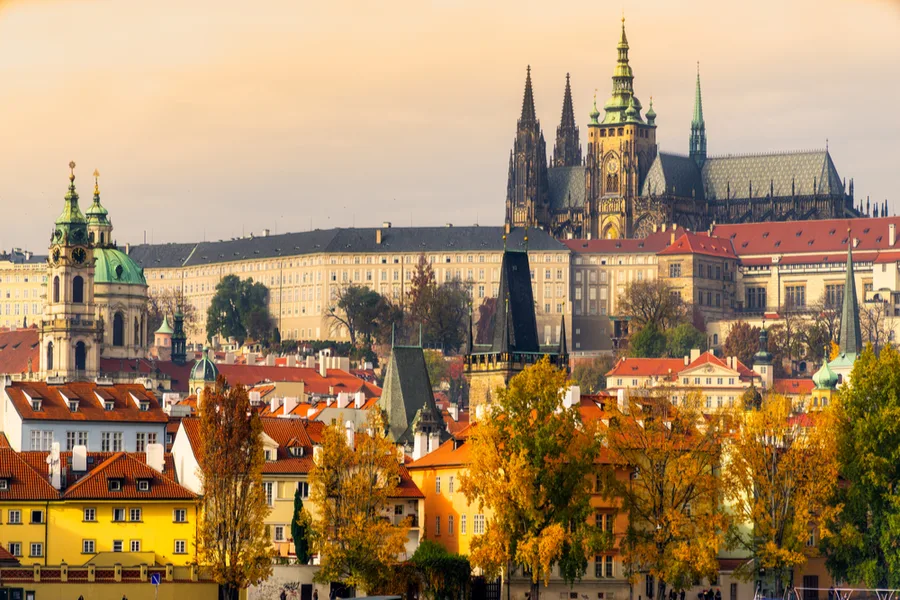
Prague Castle
 Highlight of Royal Route Guided Tour
Highlight of Royal Route Guided TourPrague Castle is one of the main attractions in Prague and is also the largest castle complex in the world.
The Prague Castle is the largest castle complex in the world with structures dating back to the 9th century. The St Vitus Cathedral and Basilica of St George can be found within the castle walls. The Prague Castle also includes several gardens, palaces, and a monastery. This castle was the seat of power for the Kings of Bohemia, Holy Roman Emperors, and presidents of former Czechoslovakia. Prague Castle is a UNESCO world heritage site and is one of the most visited places in the country.

Charles Bridge
 Highlight of Royal Route Guided Tour
Highlight of Royal Route Guided TourCross the river dividing Prague's most historic neighborhoods, and experience one of Europe's most iconic landmarks.
Bridge construction began in 1357 under King Charles IV (hence the name), and it was the only bridge across the Vltava River until 1841. 30 baroque statues of saints line the bridge, and it is filled with street artists and entertainers. Not to be missed.

Maltese Square & Lennon Wall
 Highlight of Royal Route Guided Tour
Highlight of Royal Route Guided TourSee a historic wall that has been covered in John Lennon-inspired graffiti since Communist days.
The wall has been covered in graffiti since the 1960s, and during Communism anti-regime sentiment was common. John Lennon's assassination inspired grafitti reflecting his song, Imagine, which earned the wall its current moniker. It is now a favorite gathering place for tourists, and musicians sometimes congregate there as well. Just around the corner is the Maltese Square, which is one of Prague's more quaint and relaxed public spaces, despite being just off the main tourist route.

Prague Castle
 Highlight of Royal Route Guided Tour
Highlight of Royal Route Guided TourPrague Castle is one of the main attractions in Prague and is also the largest castle complex in the world.
The Prague Castle is the largest castle complex in the world with structures dating back to the 9th century. The St Vitus Cathedral and Basilica of St George can be found within the castle walls. The Prague Castle also includes several gardens, palaces, and a monastery. This castle was the seat of power for the Kings of Bohemia, Holy Roman Emperors, and presidents of former Czechoslovakia. Prague Castle is a UNESCO world heritage site and is one of the most visited places in the country.

Charles Bridge
 Highlight of Royal Route Guided Tour
Highlight of Royal Route Guided TourCross the river dividing Prague's most historic neighborhoods, and experience one of Europe's most iconic landmarks.
Bridge construction began in 1357 under King Charles IV (hence the name), and it was the only bridge across the Vltava River until 1841. 30 baroque statues of saints line the bridge, and it is filled with street artists and entertainers. Not to be missed.
prev
next

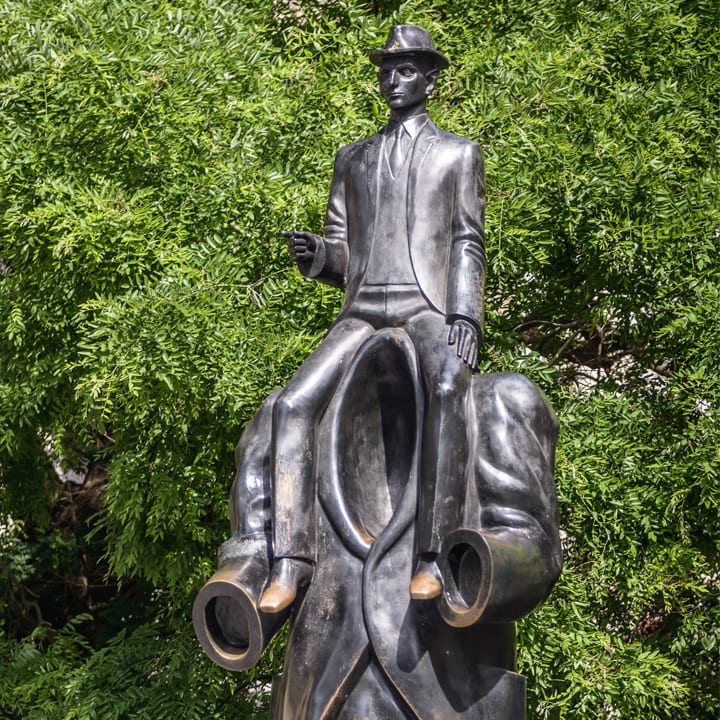
Day 13
Prague
View More
Day 13
Prague




Morning/Mid-Day
Visit Prague's Jewish Quarter
Jews have lived in Prague since its beginnings in the 10th century and have endowed it with a rich heritage. The ghetto was created in the 12th century, as Jews were forced to live separately from Christians. Despite persecution, the community prospered, but sadly, only a small minority survived the Nazi occupation. A lasting legacy remains, including synagogues, architecture, and a fascinating cemetery.

Spanish Synagogue
Discover the synagogue considered by many to be Prague's most beautiful.
Show More

Old-New Synagogue
See the oldest surviving synagogue in Europe and also one of Prague's earliest Gothic buildings.
Show More

Old Jewish Cemetery
Take an unforgettable visit to one of Europe's largest medieval Jewish cemeteries.
Show More

Spanish Synagogue
Discover the synagogue considered by many to be Prague's most beautiful.
Show More

Old-New Synagogue
See the oldest surviving synagogue in Europe and also one of Prague's earliest Gothic buildings.
Show More

Old Jewish Cemetery
Take an unforgettable visit to one of Europe's largest medieval Jewish cemeteries.
Show More

Spanish Synagogue
Discover the synagogue considered by many to be Prague's most beautiful.
Show More
prev
next

Day 13
Prague
View More

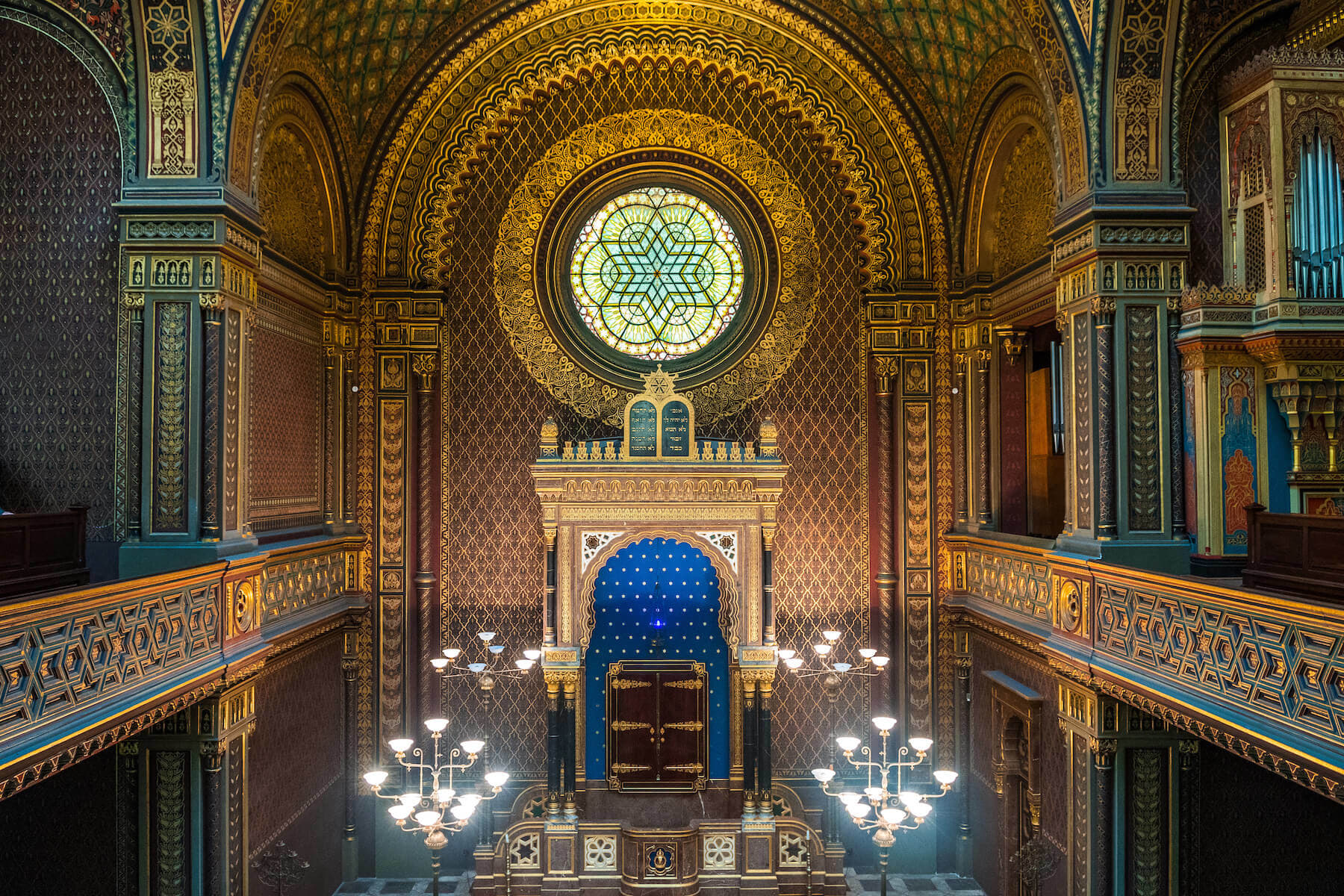
Spanish Synagogue
 Highlight of Jewish Quarter
Highlight of Jewish QuarterDiscover the synagogue considered by many to be Prague's most beautiful.
Completed in 1868, the Spanish Synagogue is the newest synagogue in Prague's Jewish Quarter, but happens to be built on the site of the former Oldest Synagogue in Prague. It is built in a stunning Spanish Moorish style as a symbol of the flowering of the Jewish culture which occurred under Muslim rule on the Iberian Peninsula.
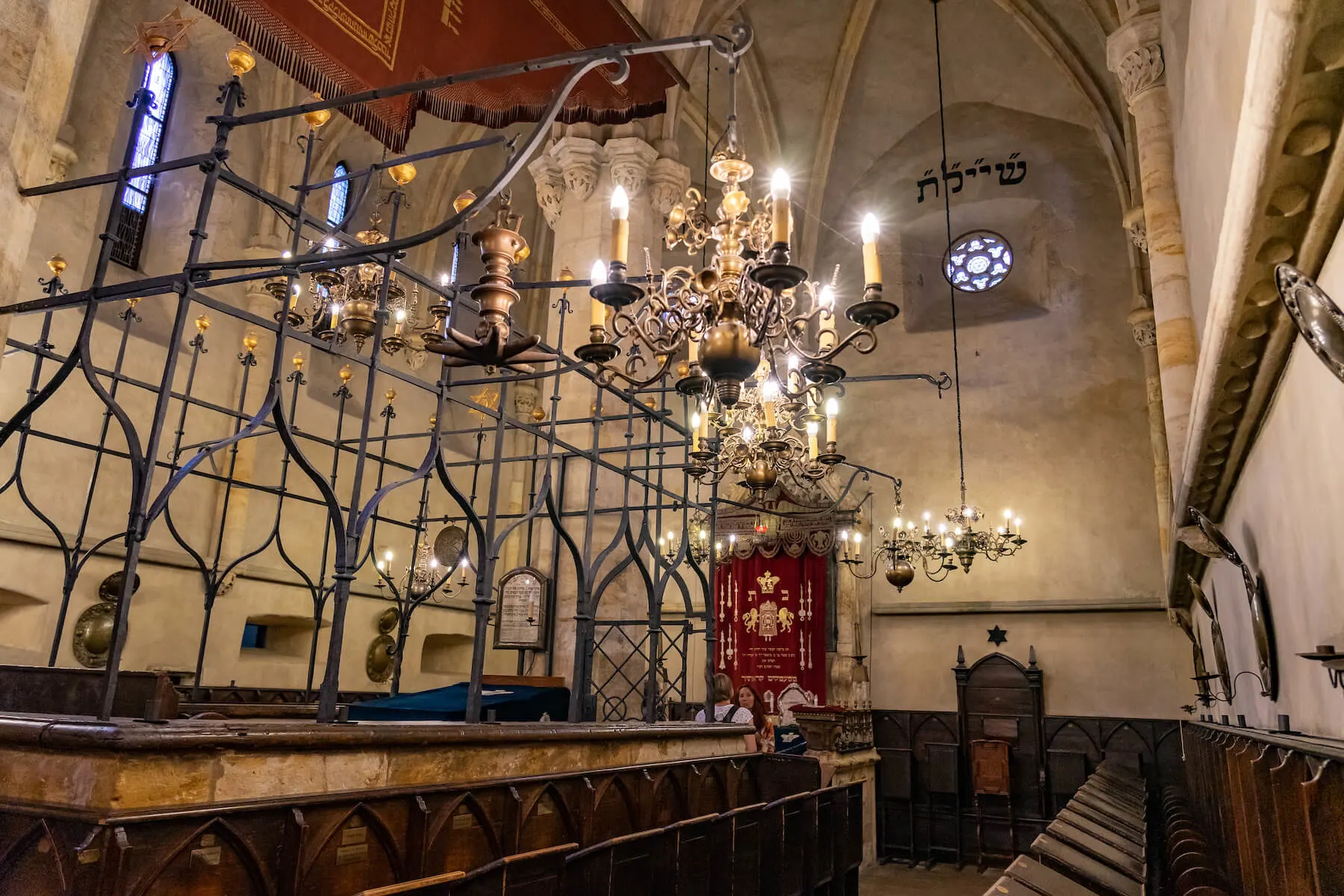
Old-New Synagogue
 Highlight of Jewish Quarter
Highlight of Jewish QuarterSee the oldest surviving synagogue in Europe and also one of Prague's earliest Gothic buildings.
When built it was Prague’s newest synagogue, but over time became its oldest – hence the “Old-New”. A beautiful ark holds the Torah and legend says its attic is the hiding place of the legendary clay Golem.
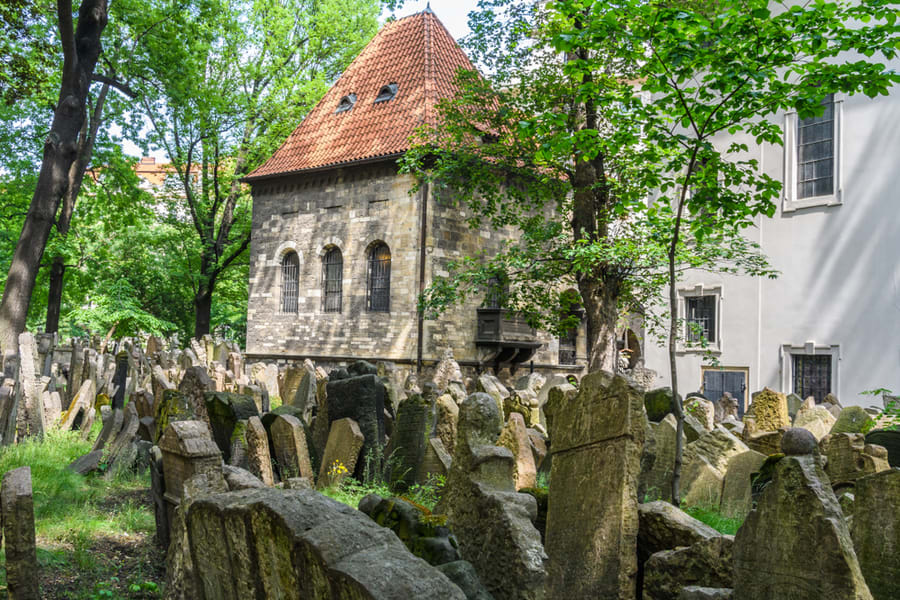
Old Jewish Cemetery
 Highlight of Jewish Quarter
Highlight of Jewish QuarterTake an unforgettable visit to one of Europe's largest medieval Jewish cemeteries.
As the Jewish Ghetto was quite cramped, there was no room to expand the cemetery. Unable to acquire further land, and not wishing to dishonor ancestors through the demolition of existing graves, Prague's Jews buried their loved ones in multiple levels. Gravestones are packed in tightly and in some areas the burials reach 12 layers!

Spanish Synagogue
 Highlight of Jewish Quarter
Highlight of Jewish QuarterDiscover the synagogue considered by many to be Prague's most beautiful.
Completed in 1868, the Spanish Synagogue is the newest synagogue in Prague's Jewish Quarter, but happens to be built on the site of the former Oldest Synagogue in Prague. It is built in a stunning Spanish Moorish style as a symbol of the flowering of the Jewish culture which occurred under Muslim rule on the Iberian Peninsula.

Old-New Synagogue
 Highlight of Jewish Quarter
Highlight of Jewish QuarterSee the oldest surviving synagogue in Europe and also one of Prague's earliest Gothic buildings.
When built it was Prague’s newest synagogue, but over time became its oldest – hence the “Old-New”. A beautiful ark holds the Torah and legend says its attic is the hiding place of the legendary clay Golem.

Old Jewish Cemetery
 Highlight of Jewish Quarter
Highlight of Jewish QuarterTake an unforgettable visit to one of Europe's largest medieval Jewish cemeteries.
As the Jewish Ghetto was quite cramped, there was no room to expand the cemetery. Unable to acquire further land, and not wishing to dishonor ancestors through the demolition of existing graves, Prague's Jews buried their loved ones in multiple levels. Gravestones are packed in tightly and in some areas the burials reach 12 layers!

Spanish Synagogue
 Highlight of Jewish Quarter
Highlight of Jewish QuarterDiscover the synagogue considered by many to be Prague's most beautiful.
Completed in 1868, the Spanish Synagogue is the newest synagogue in Prague's Jewish Quarter, but happens to be built on the site of the former Oldest Synagogue in Prague. It is built in a stunning Spanish Moorish style as a symbol of the flowering of the Jewish culture which occurred under Muslim rule on the Iberian Peninsula.
prev
next

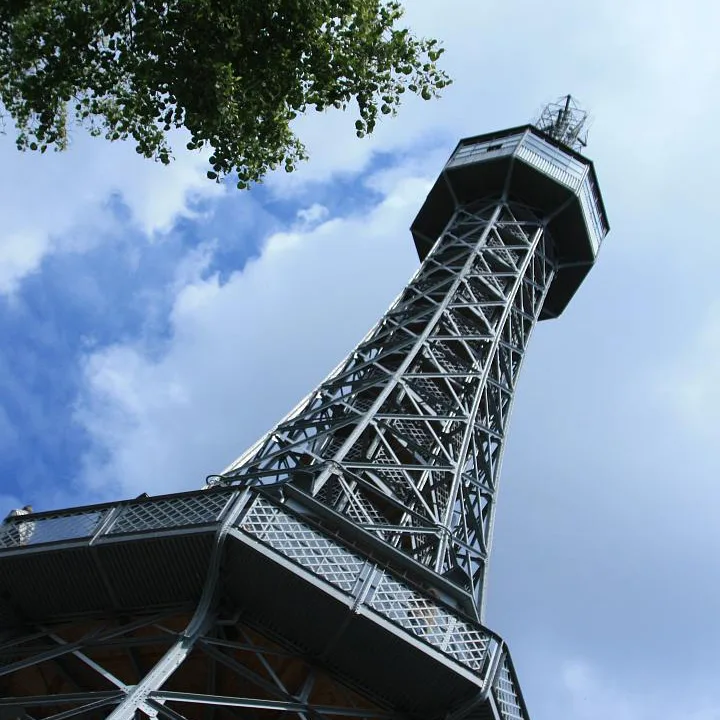
Day 14
Prague to Vienna
View More
Day 14
Prague to Vienna





Morning
Stroll through Petřín Park
Petřin Park is Prague's most prominent park, as it is located on the side of a large hill overlooking the city. The park is filled with cherry orchards, beautiful forests, and lawns, and is crisscrossed by numerous paths as well as the medieval Hunger Wall built by Emperor Charles IV. At the top of the park is an Eiffel Tower-like observation tower which provides an unobstructed view of the city.

Petřín Mirror Labyrinth
Get delightfully lost in a 19th-century, mirrored labyrinth.
Show More

Petřín Funicular Railway
Ride an incline railway to the top of the wooded Petřín Hill to discover forest paths and beautiful city views.
Show More

Petřín Observatory Tower
Ascend the Czech version of the Eiffel Tower for an astounding 360-degree view.
Show More

Petřín Mirror Labyrinth
Get delightfully lost in a 19th-century, mirrored labyrinth.
Show More

Petřín Funicular Railway
Ride an incline railway to the top of the wooded Petřín Hill to discover forest paths and beautiful city views.
Show More

Petřín Observatory Tower
Ascend the Czech version of the Eiffel Tower for an astounding 360-degree view.
Show More

Petřín Mirror Labyrinth
Get delightfully lost in a 19th-century, mirrored labyrinth.
Show More
prev
next

Day 14
Prague to Vienna
View More

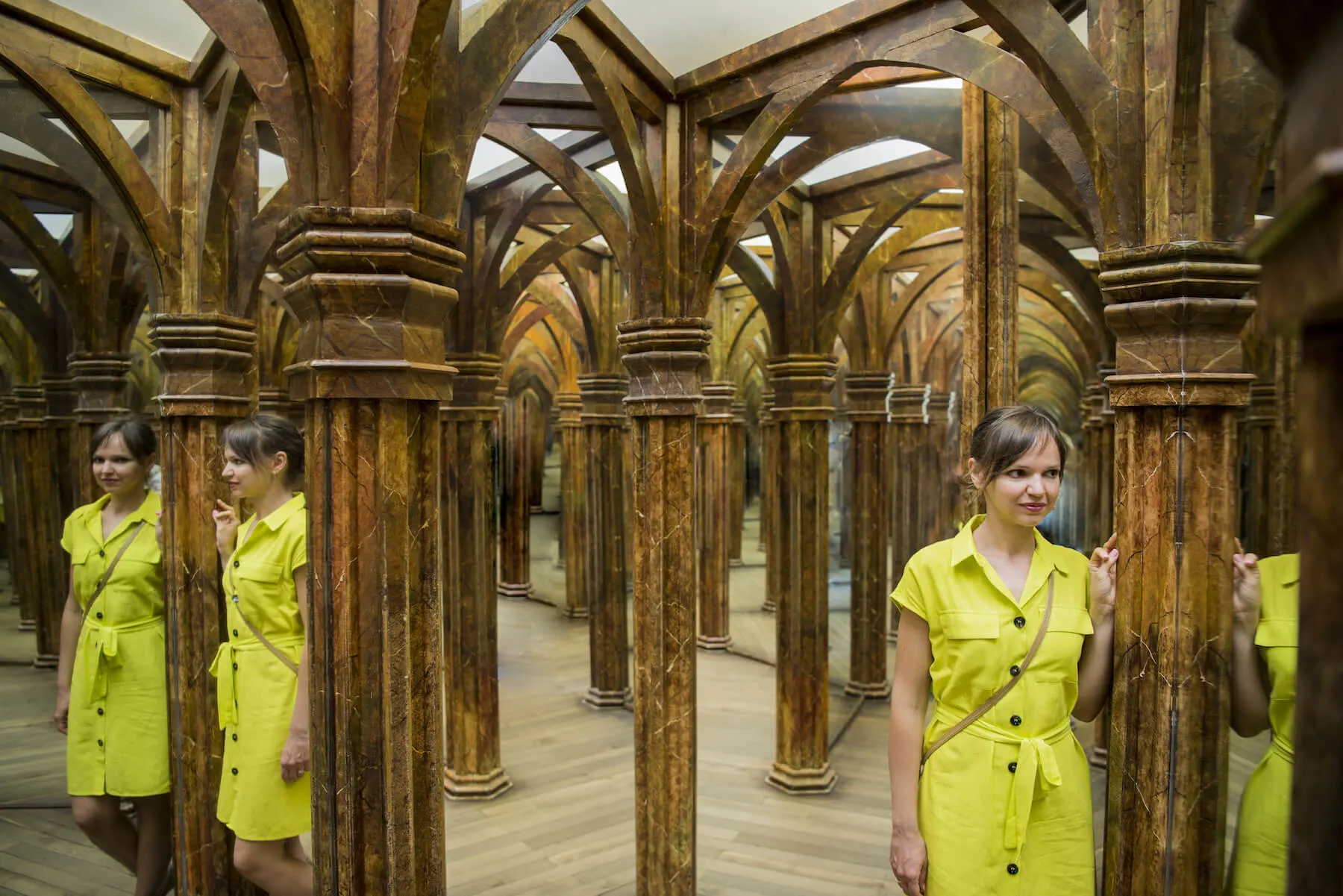
Petřín Mirror Labyrinth
 Highlight of Petřín Park
Highlight of Petřín ParkGet delightfully lost in a 19th-century, mirrored labyrinth.
This maze of mirrors was created for an 1891 Exhibition, and it was so popular that it is still open today. It is great fun for kids and adults, especially the trick mirrors. There is also a mural showing a battle which took place on the Charles Bridge in 1648.
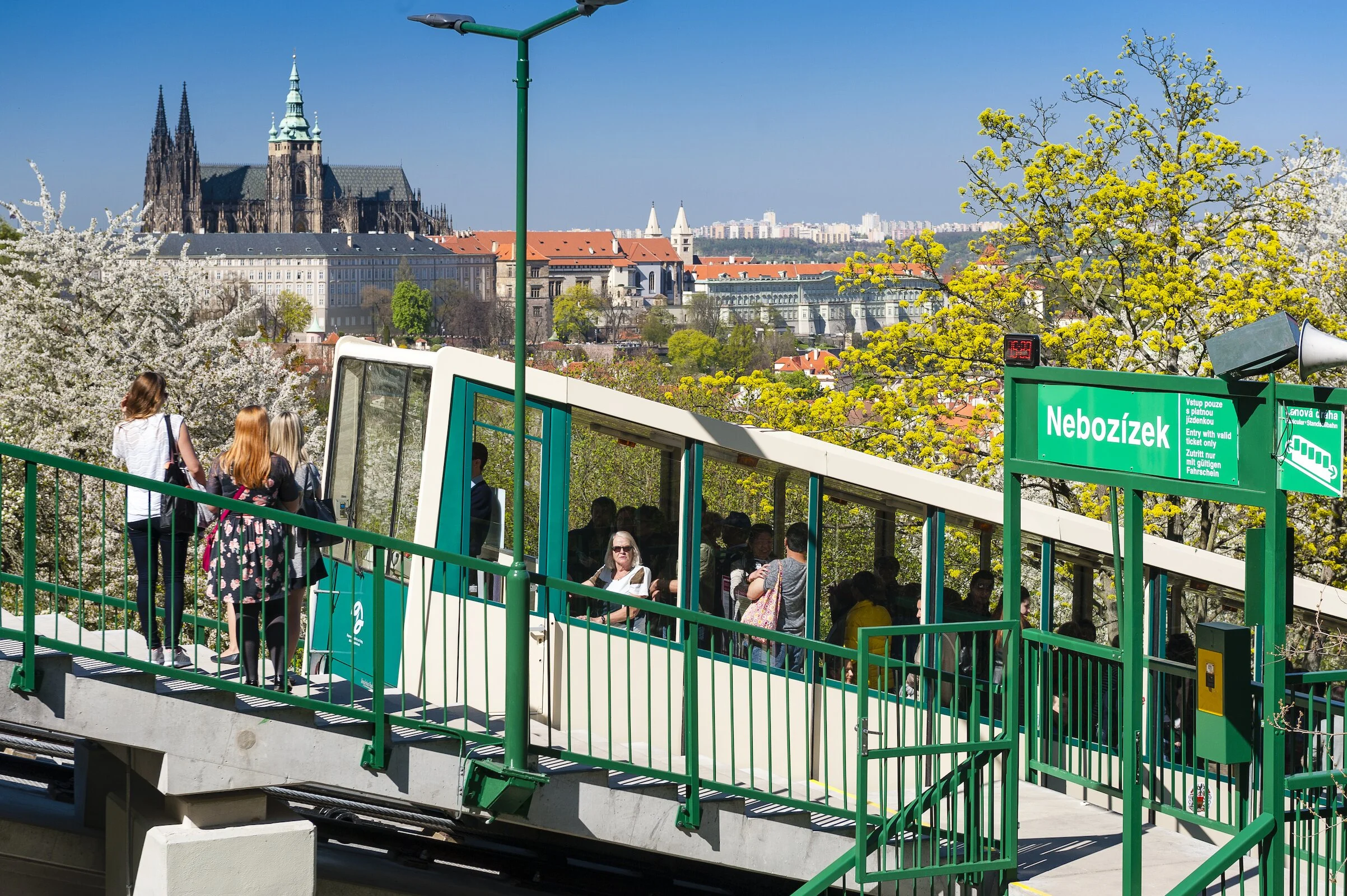
Petřín Funicular Railway
 Highlight of Petřín Park
Highlight of Petřín ParkRide an incline railway to the top of the wooded Petřín Hill to discover forest paths and beautiful city views.
This inclined railway takes visitors to the top of Petřín Hill, where they can ascend the Observation Tower or take a walk through the beautiful forest park overlooking Prague. Riders can also get off at the middle station of the railway and visit one of several restaurants overlooking the city.
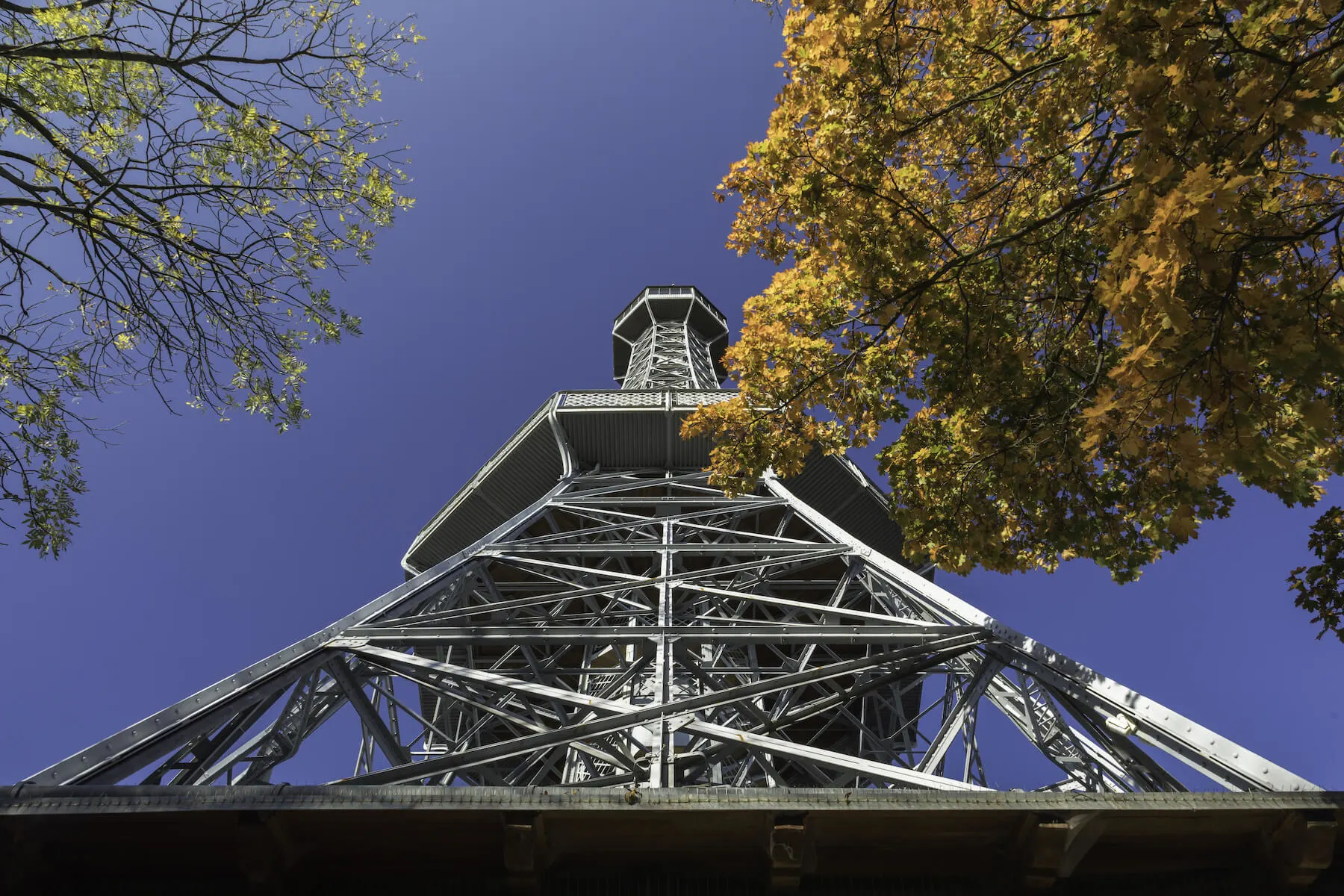
Petřín Observatory Tower
 Highlight of Petřín Park
Highlight of Petřín ParkAscend the Czech version of the Eiffel Tower for an astounding 360-degree view.
Petřín Observatory Tower is a cast iron observation tower, built in 1891, that resembles the Eiffel Tower in Paris. Although this structure is only 64m tall, because it is built on a hill it is technically higher than the Eiffel Tower. Visitors enjoy a panoramic view of not only the city center, but also the suburbs and countryside surrounding Prague.

Petřín Mirror Labyrinth
 Highlight of Petřín Park
Highlight of Petřín ParkGet delightfully lost in a 19th-century, mirrored labyrinth.
This maze of mirrors was created for an 1891 Exhibition, and it was so popular that it is still open today. It is great fun for kids and adults, especially the trick mirrors. There is also a mural showing a battle which took place on the Charles Bridge in 1648.

Petřín Funicular Railway
 Highlight of Petřín Park
Highlight of Petřín ParkRide an incline railway to the top of the wooded Petřín Hill to discover forest paths and beautiful city views.
This inclined railway takes visitors to the top of Petřín Hill, where they can ascend the Observation Tower or take a walk through the beautiful forest park overlooking Prague. Riders can also get off at the middle station of the railway and visit one of several restaurants overlooking the city.

Petřín Observatory Tower
 Highlight of Petřín Park
Highlight of Petřín ParkAscend the Czech version of the Eiffel Tower for an astounding 360-degree view.
Petřín Observatory Tower is a cast iron observation tower, built in 1891, that resembles the Eiffel Tower in Paris. Although this structure is only 64m tall, because it is built on a hill it is technically higher than the Eiffel Tower. Visitors enjoy a panoramic view of not only the city center, but also the suburbs and countryside surrounding Prague.

Petřín Mirror Labyrinth
 Highlight of Petřín Park
Highlight of Petřín ParkGet delightfully lost in a 19th-century, mirrored labyrinth.
This maze of mirrors was created for an 1891 Exhibition, and it was so popular that it is still open today. It is great fun for kids and adults, especially the trick mirrors. There is also a mural showing a battle which took place on the Charles Bridge in 1648.
prev
next


Day 15
Vienna
View More
Day 15
Vienna




9:00 AM - 11:30 AM
Guided Walk through Vienna's Inner City
This tour takes you back in history to explore the Vienna that stood within the old city walls. You will learn about the humble beginnings of Vienna before it became the capital of a great empire and one of the most important cities in Europe. You will discover how Vienna's early inhabitants lived and how they left their mark on the city and its beautiful Medieval, Renaissance, and Baroque architecture.

Day 15
Vienna
View More


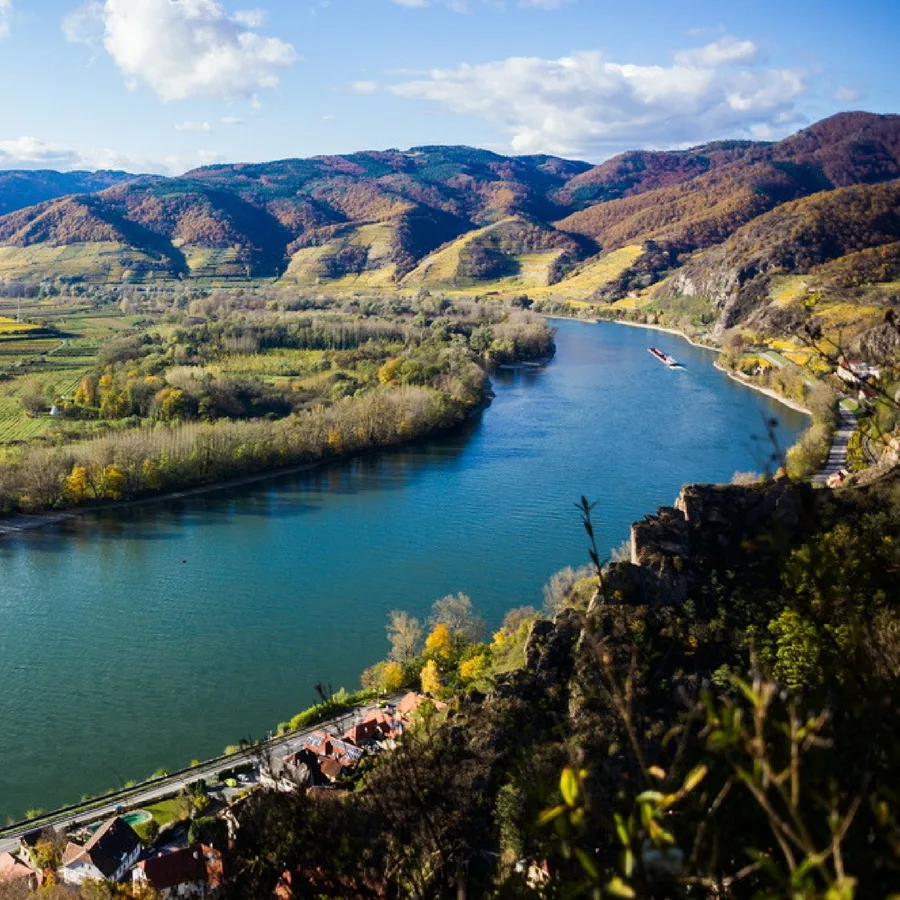
Day 16
Vienna
View More
Day 16
Vienna

Early Morning to Early Evening
Danube Cruise in the Scenic Wachau Valley
A one-and-a-half-hour train ride from Vienna brings you to the town of Melk, where you can tour the vast Melk Abbey. From there you can begin a 22-mile cruise through the Wachau Valley, considered the most beautiful stretch of the entire Danube River. You'll pass medieval castle ruins, hills covered in vineyards, and several charming villages, where you can debark to try some wine or take a hike up to a castle. The valley is also a perfect destination for cyclers and winery tours.

Dürnstein
Explore the twisting narrow lanes of this delightful monastery town.
Show More

Dürnstein Castle Ruins
Hike to the dramatic ruins of a medieval castle built in 1100's.
Show More

Melk Abbey
Tour a huge and splendid Baroque monastery.
Show More

Spitz
Stop to taste the wine in a postcard-pretty town surrounded by vineyards.
Show More

Dürnstein
Explore the twisting narrow lanes of this delightful monastery town.
Show More

Dürnstein Castle Ruins
Hike to the dramatic ruins of a medieval castle built in 1100's.
Show More

Melk Abbey
Tour a huge and splendid Baroque monastery.
Show More

Spitz
Stop to taste the wine in a postcard-pretty town surrounded by vineyards.
Show More
prev
next

Day 16
Vienna
View More

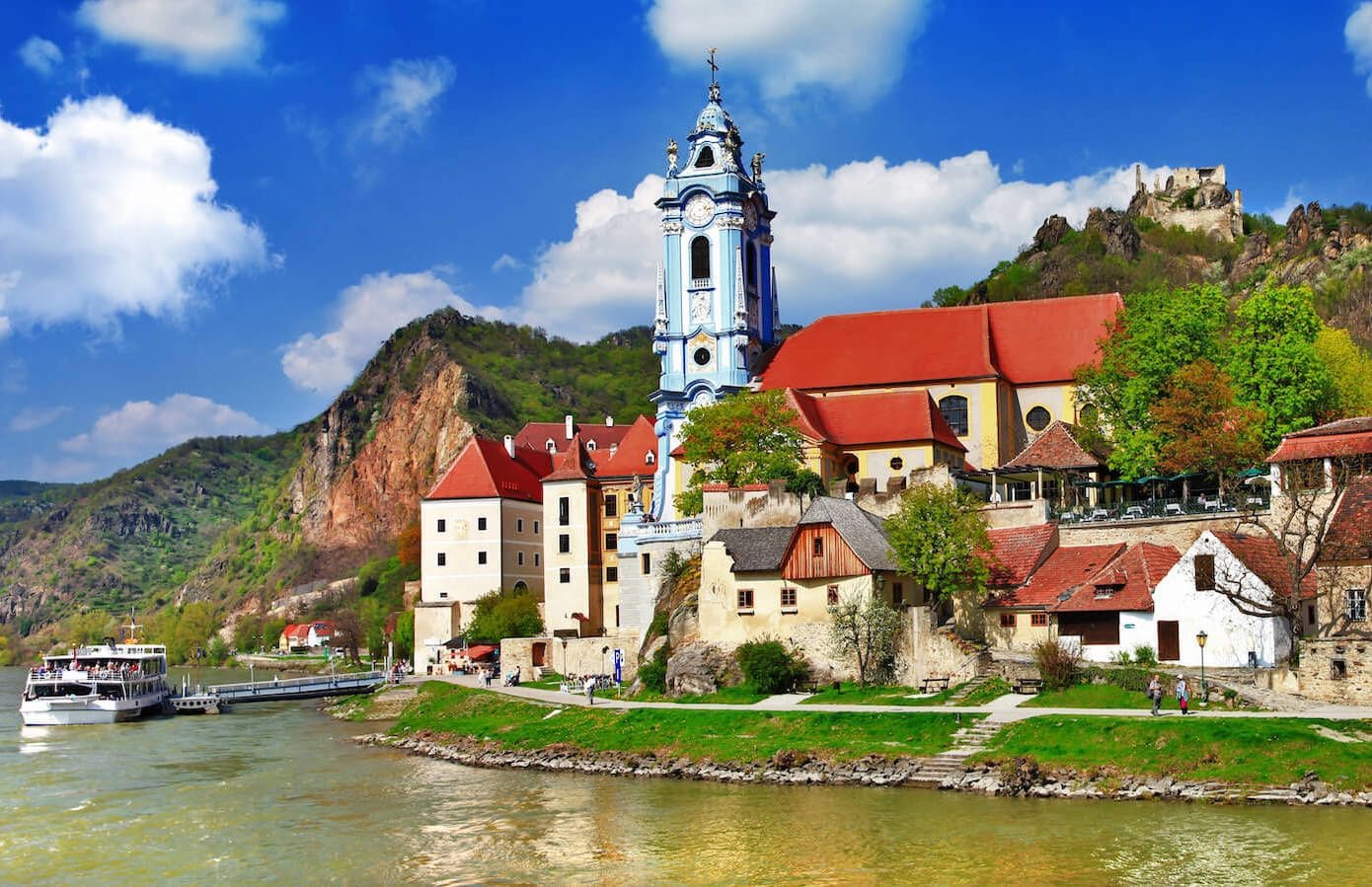
Dürnstein
 Highlight of Wachau Valley
Highlight of Wachau ValleyExplore the twisting narrow lanes of this delightful monastery town.
Named for the castle that overlooks it, Dürnstein is probably the most-visited stop in the Wachau valley. Reached by an ancient tunnel leading from the boat docks, it is well-known for its wine as well as the beautiful blue church tower of its Augustinian monastery.
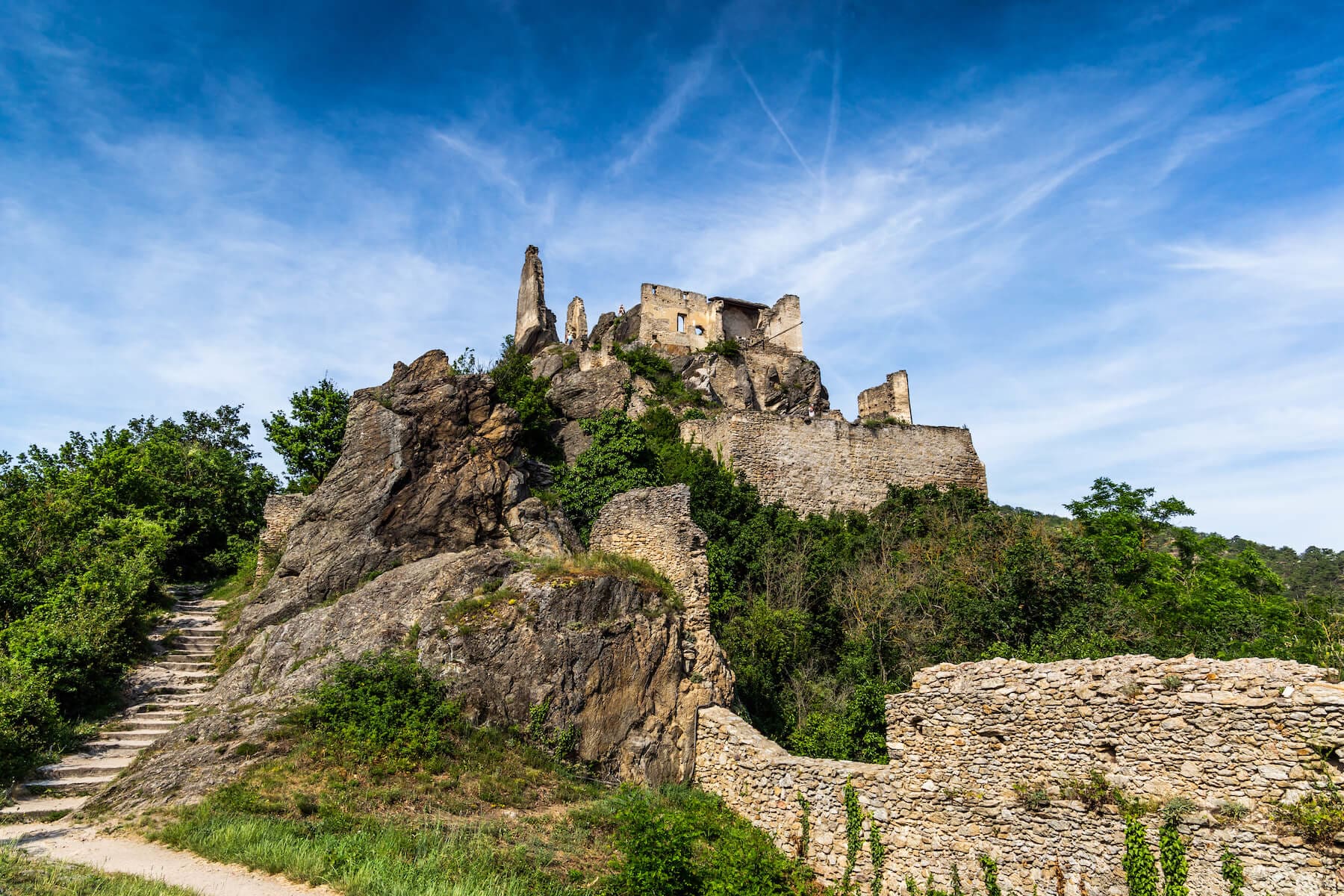
Dürnstein Castle Ruins
 Highlight of Wachau Valley
Highlight of Wachau ValleyHike to the dramatic ruins of a medieval castle built in 1100's.
The hike leading to the castle is steep, but the amazing view you are rewarded with makes it all worth while. The fascinating ruins are extensive and can be freely explored. The castle was made famous by its most illustrious prisoner, King Richard the Lionhearted of England, who was held there for ransom.
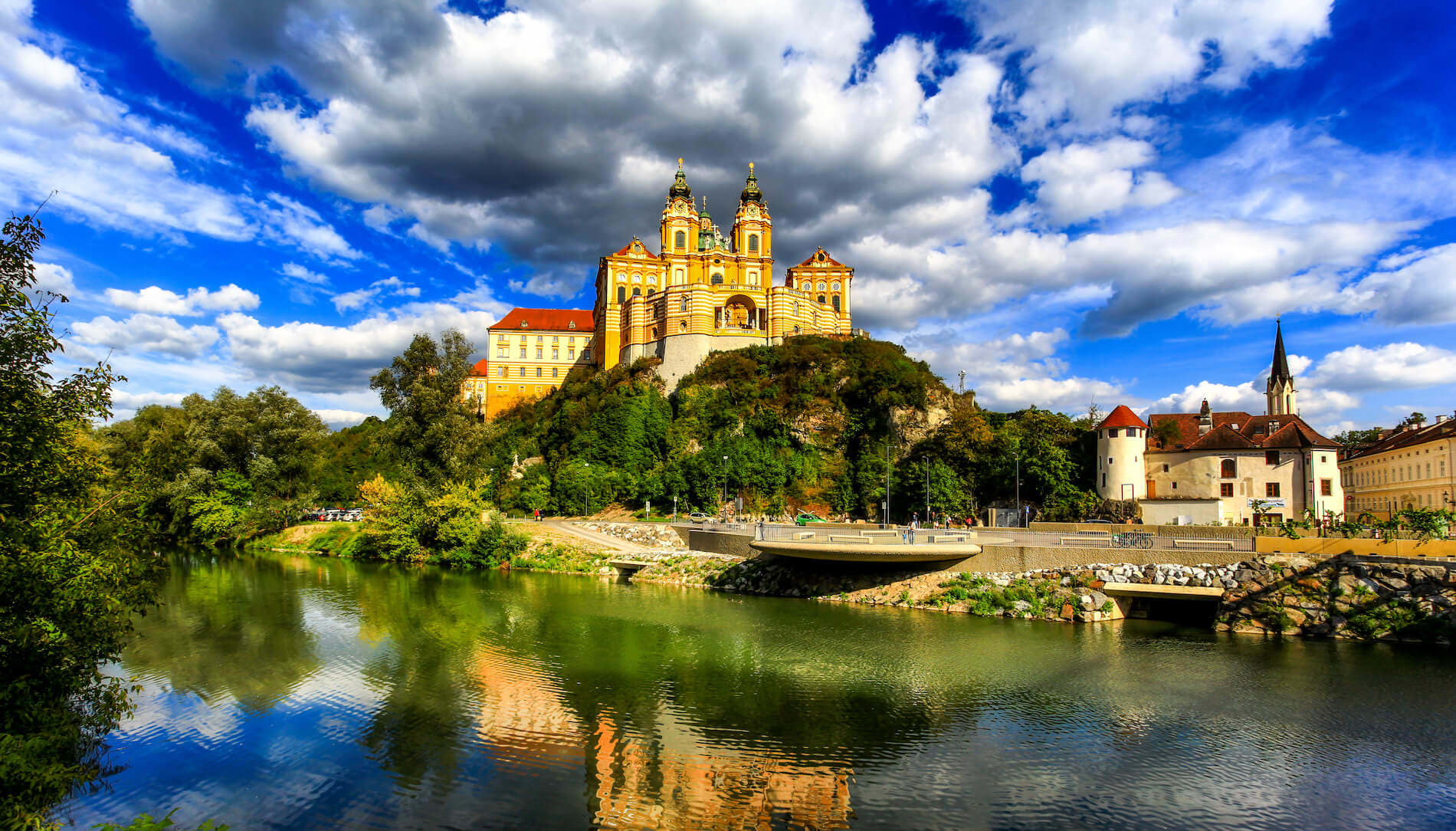
Melk Abbey
 Highlight of Wachau Valley
Highlight of Wachau ValleyTour a huge and splendid Baroque monastery.
Founded in 1089 when the Austrian duke gave one of his castles to Benedictine monks, Melk Abbey is now both a place of pilgrimage and a major tourist attraction. Visitors come for the museum of religious artifacts, the jaw-dropping library, and the sublime church. The town square below the abbey is also a great place for a meal or wine.
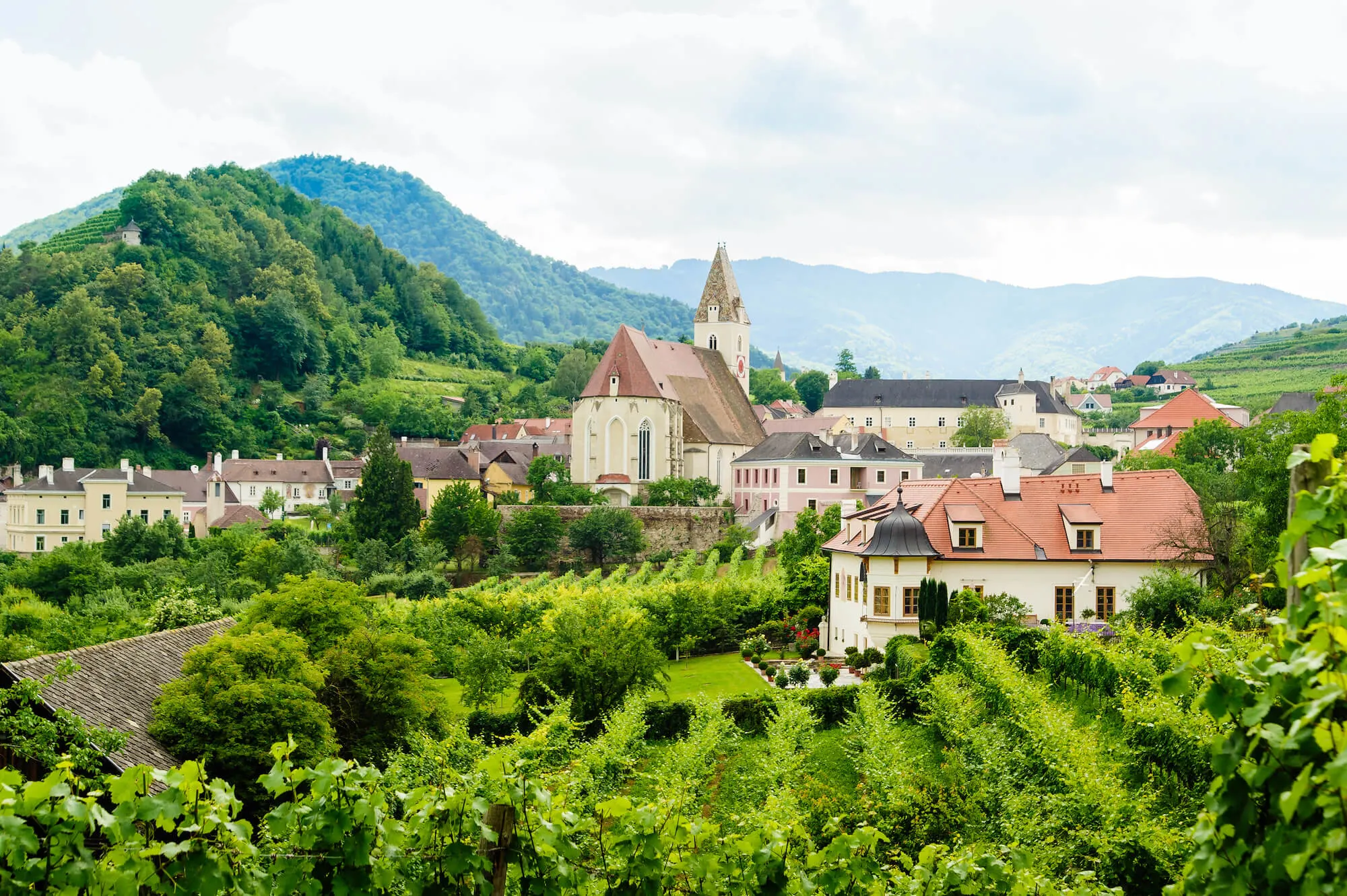
Spitz
 Highlight of Wachau Valley
Highlight of Wachau ValleyStop to taste the wine in a postcard-pretty town surrounded by vineyards.
Spitz is a favorite stop due to its bucolic atmosphere and abundance of wine taverns and restaurants. It is also home to the Tausendeimerberg or "House of a Thousand Buckets" (so named for the abundance of wine fields) and the castle ruins of Hinterhaus, which make for a nice (if steep) hike from the village.

Dürnstein
 Highlight of Wachau Valley
Highlight of Wachau ValleyExplore the twisting narrow lanes of this delightful monastery town.
Named for the castle that overlooks it, Dürnstein is probably the most-visited stop in the Wachau valley. Reached by an ancient tunnel leading from the boat docks, it is well-known for its wine as well as the beautiful blue church tower of its Augustinian monastery.

Dürnstein Castle Ruins
 Highlight of Wachau Valley
Highlight of Wachau ValleyHike to the dramatic ruins of a medieval castle built in 1100's.
The hike leading to the castle is steep, but the amazing view you are rewarded with makes it all worth while. The fascinating ruins are extensive and can be freely explored. The castle was made famous by its most illustrious prisoner, King Richard the Lionhearted of England, who was held there for ransom.

Melk Abbey
 Highlight of Wachau Valley
Highlight of Wachau ValleyTour a huge and splendid Baroque monastery.
Founded in 1089 when the Austrian duke gave one of his castles to Benedictine monks, Melk Abbey is now both a place of pilgrimage and a major tourist attraction. Visitors come for the museum of religious artifacts, the jaw-dropping library, and the sublime church. The town square below the abbey is also a great place for a meal or wine.

Spitz
 Highlight of Wachau Valley
Highlight of Wachau ValleyStop to taste the wine in a postcard-pretty town surrounded by vineyards.
Spitz is a favorite stop due to its bucolic atmosphere and abundance of wine taverns and restaurants. It is also home to the Tausendeimerberg or "House of a Thousand Buckets" (so named for the abundance of wine fields) and the castle ruins of Hinterhaus, which make for a nice (if steep) hike from the village.
prev
next

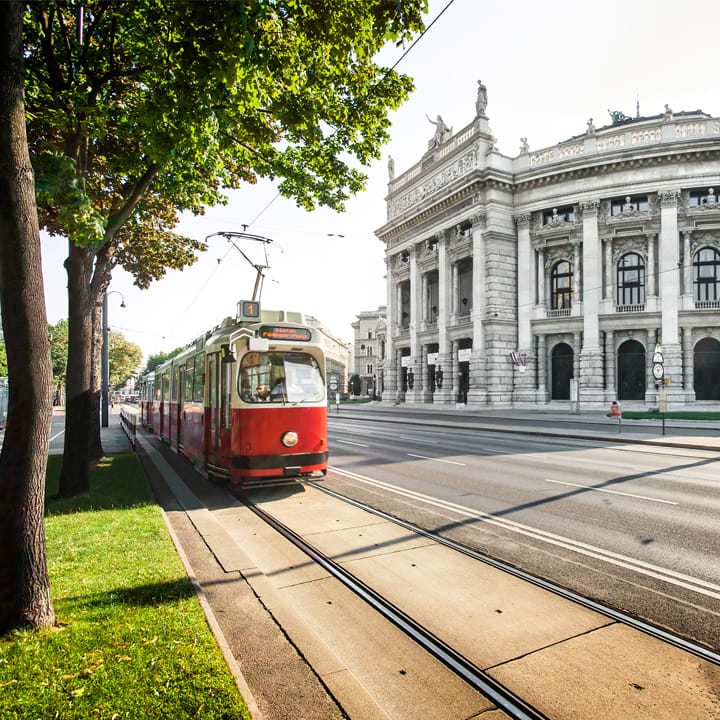
Day 17
Vienna to Budapest
View More
Day 17
Vienna to Budapest





Morning/Mid-Day
Along Vienna's Ringstraße (Ring Street)
The Ringstrasse, or the Ring Street, surrounds Vienna's old town where the city walls once stood until the 19th century. The Austro-Hungarian Empire was at the height of its prosperity at the time the walls were torn down, and so it lined the wide Ringstrasse with monumental buildings such as the neo-Gothic town hall and neo-Classical parliament buildling. A fun experience is to take a tram ride around the entire length of the Ringstrasse, soaking in the full richness of the spectacle.

Natural History Museum
Explore one of the world's most important natural history collections.
Show More

Kunsthistorisches Museum
Find artistic bliss in this lavish 19th-century museum housing art collections & antiquities.
Show More

Rathaus (City Hall)
Get in touch with the local vibe at the Rathausplatz, a huge square in front of the Vienna City Hall.
Show More

Natural History Museum
Explore one of the world's most important natural history collections.
Show More

Kunsthistorisches Museum
Find artistic bliss in this lavish 19th-century museum housing art collections & antiquities.
Show More

Rathaus (City Hall)
Get in touch with the local vibe at the Rathausplatz, a huge square in front of the Vienna City Hall.
Show More

Natural History Museum
Explore one of the world's most important natural history collections.
Show More
prev
next

Day 17
Vienna to Budapest
View More


Natural History Museum
 Highlight of Ring Street
Highlight of Ring StreetExplore one of the world's most important natural history collections.
The museum is a treasure trove of anthropological and archeological exhibits, including dinosaurs and other extinct animals, precious gems, and more. It also holds the famous pre-historic finds from the Austrian village of Hallstatt, where an ancient salt mine was located.
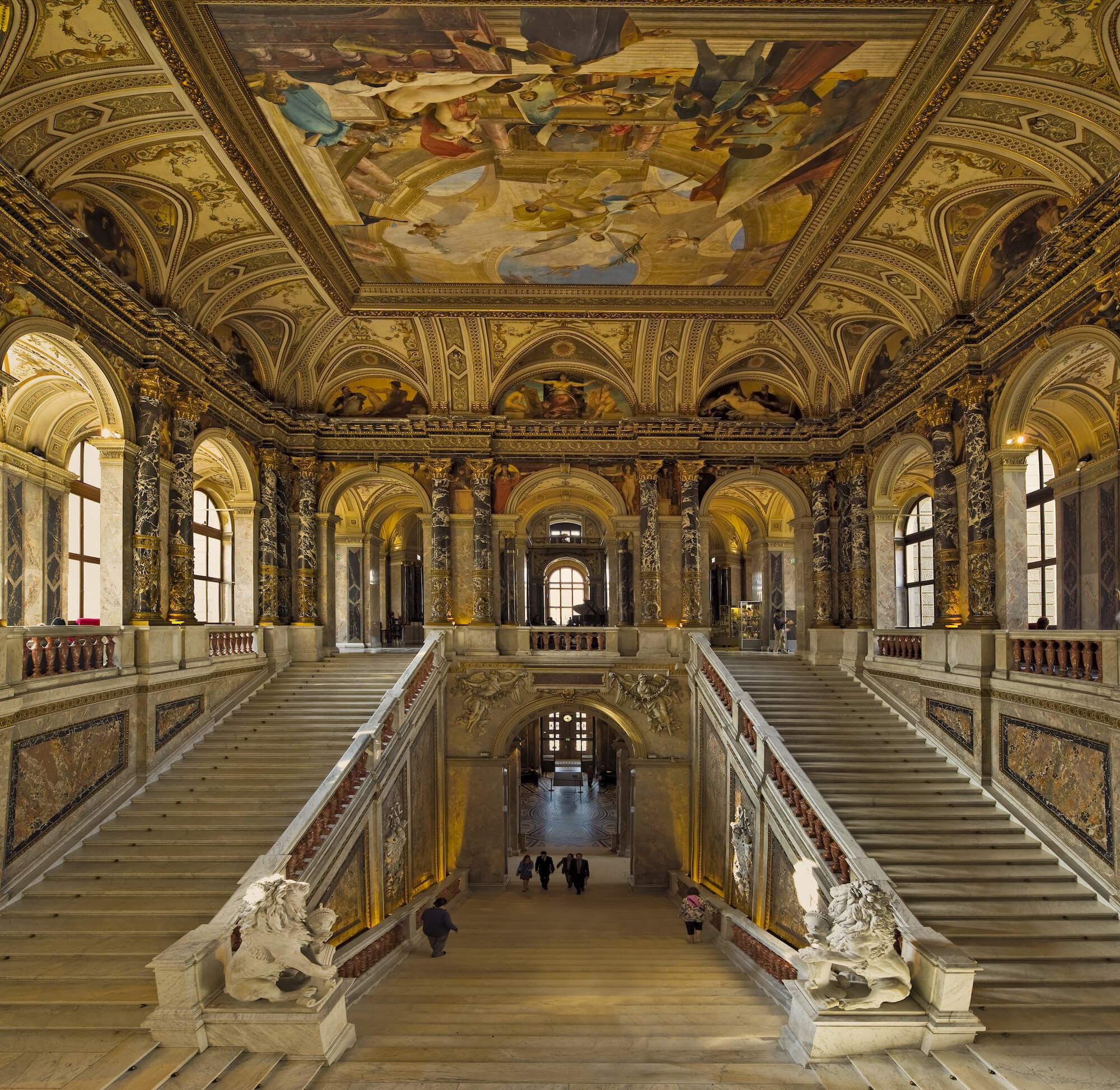
Kunsthistorisches Museum
 Highlight of Ring Street
Highlight of Ring StreetFind artistic bliss in this lavish 19th-century museum housing art collections & antiquities.
The Kunsthistorisches Museum, or Art History Museum, is one of the world's most important collections of art. It houses many masterpieces as well as ancient and classical art antiquities. Its amazing interior is worth seeing just on its own merits, and includes an incredible mural painted by Gustav Klimt.
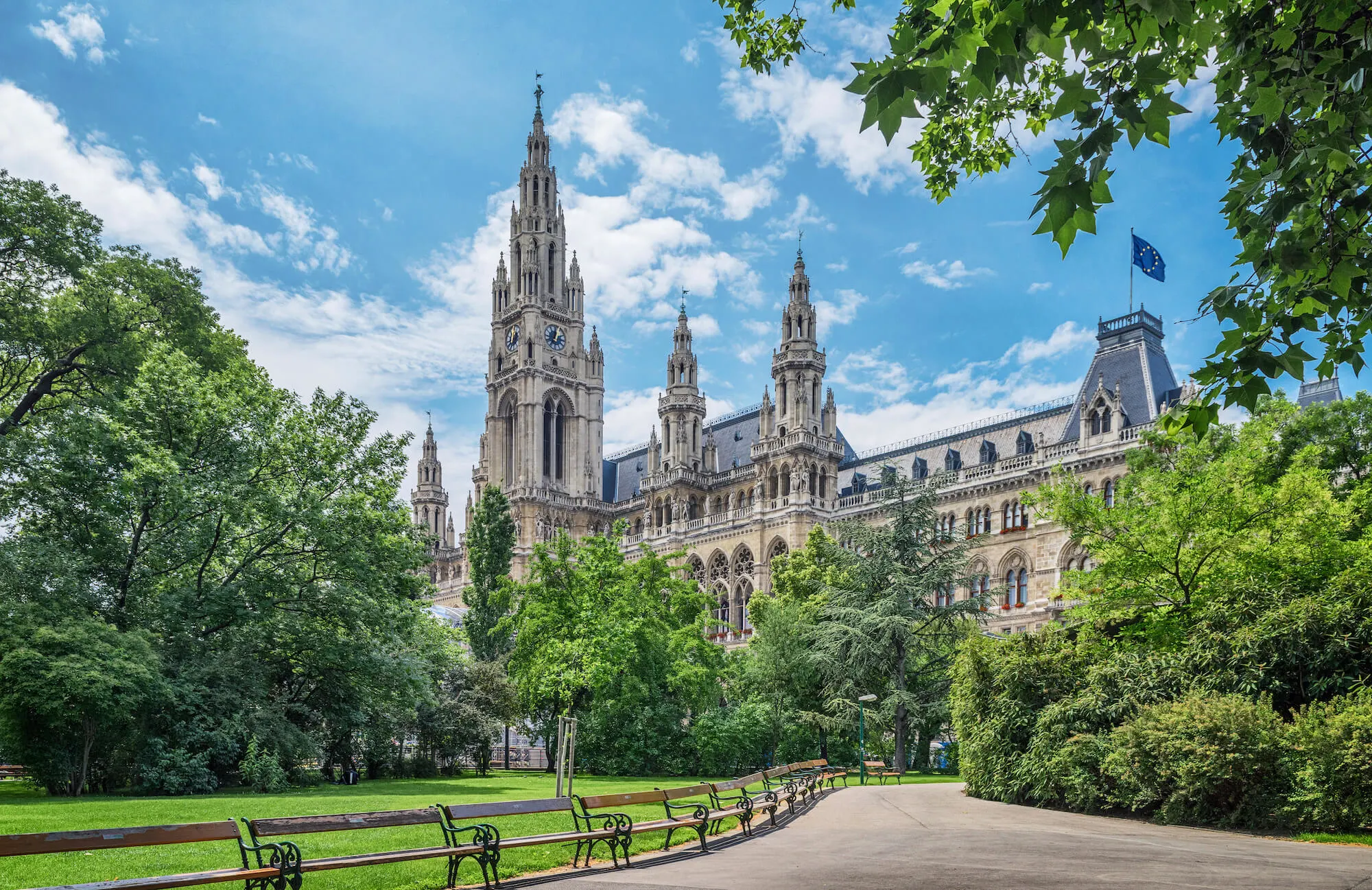
Rathaus (City Hall)
 Highlight of Ring Street
Highlight of Ring StreetGet in touch with the local vibe at the Rathausplatz, a huge square in front of the Vienna City Hall.
The 19th-century city hall was built in a fanciful neo-Gothic style with 30 million bricks. It is an important center for social life in the city, hosting balls, concerts, and other events. The square in front of the hall is home to activities all year long, including markets, food fairs, exhibitions, and the city's biggest Christmas Market.

Natural History Museum
 Highlight of Ring Street
Highlight of Ring StreetExplore one of the world's most important natural history collections.
The museum is a treasure trove of anthropological and archeological exhibits, including dinosaurs and other extinct animals, precious gems, and more. It also holds the famous pre-historic finds from the Austrian village of Hallstatt, where an ancient salt mine was located.

Kunsthistorisches Museum
 Highlight of Ring Street
Highlight of Ring StreetFind artistic bliss in this lavish 19th-century museum housing art collections & antiquities.
The Kunsthistorisches Museum, or Art History Museum, is one of the world's most important collections of art. It houses many masterpieces as well as ancient and classical art antiquities. Its amazing interior is worth seeing just on its own merits, and includes an incredible mural painted by Gustav Klimt.

Rathaus (City Hall)
 Highlight of Ring Street
Highlight of Ring StreetGet in touch with the local vibe at the Rathausplatz, a huge square in front of the Vienna City Hall.
The 19th-century city hall was built in a fanciful neo-Gothic style with 30 million bricks. It is an important center for social life in the city, hosting balls, concerts, and other events. The square in front of the hall is home to activities all year long, including markets, food fairs, exhibitions, and the city's biggest Christmas Market.

Natural History Museum
 Highlight of Ring Street
Highlight of Ring StreetExplore one of the world's most important natural history collections.
The museum is a treasure trove of anthropological and archeological exhibits, including dinosaurs and other extinct animals, precious gems, and more. It also holds the famous pre-historic finds from the Austrian village of Hallstatt, where an ancient salt mine was located.
prev
next

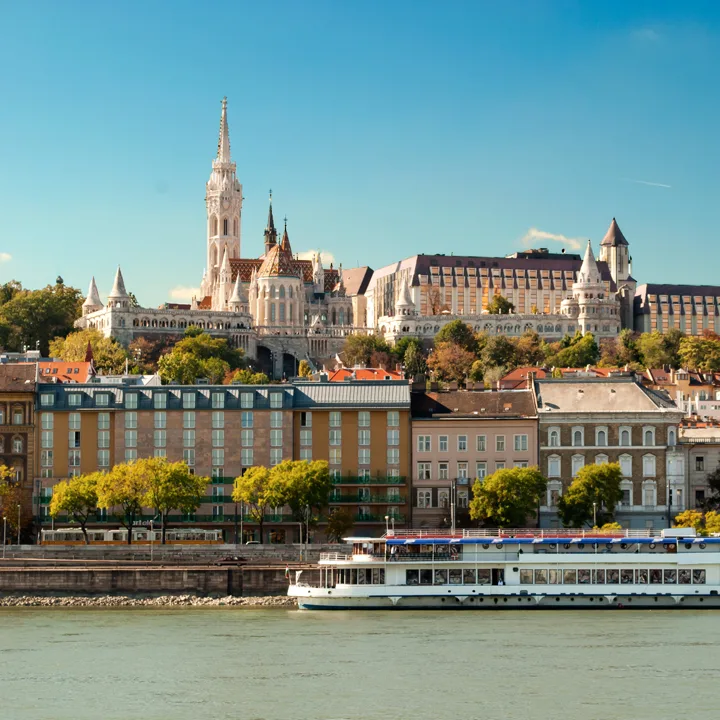
Day 18
Budapest
View More
Day 18
Budapest



9:00 AM - 12:30 PM
Best of Budapest: Half-Day Walking Tour of Highlights & Hidden Finds
During your tour you will take in a gorgeous vista of the city from the Fisherman's Bastion, explore the winding streets of the Castle District, gaze in awe at the striking interior of St. Stephen's Basilica, travel along the city's most elegant avenue and more. Along the way you will experience the city as a local does, stopping to check out intimate courtyards, enjoying a pastry and soaking in the ambiance of Budapest's most elegant cafes.

Day 18
Budapest
View More


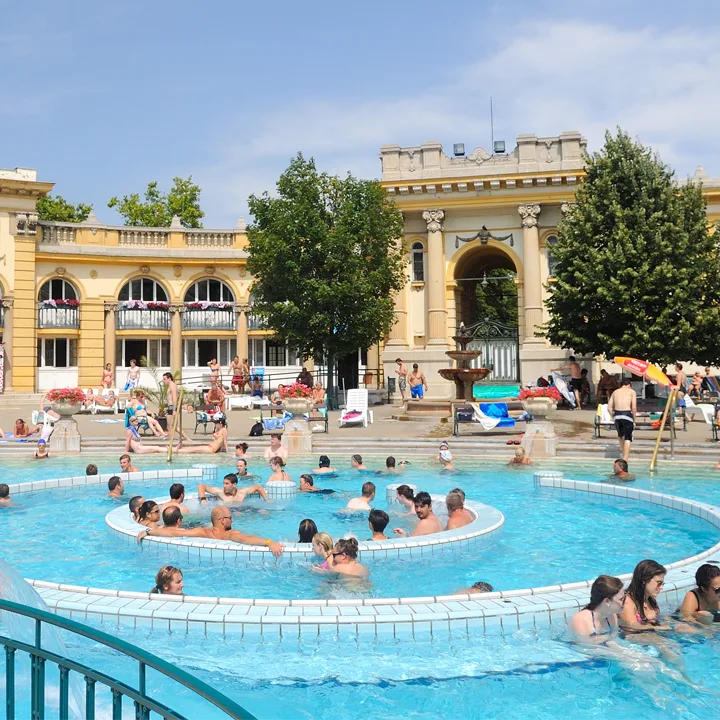
Day 19
Budapest
View More
Day 19
Budapest




Early Morning to Mid-Day
Szechenyi Baths, Vajdahunyad Castle, Zoo, and Heroes' Square
The Széchenyi Baths are the largest and the most popular of all the city's baths. With eighteen indoor and outdoor pools and impressive neo-Baroque architecture, the baths make for an unforgettable visit. Nearby, you will find the fascinating Vajdahunyad Castle, a delightful zoo, and the monumental Heroes’ Square, which tells a 1,000-year old tale of Hungarian history.

Vajdahunyad Castle
This fantastical castle with a boating lake shows the evolution of Hungarian architecture in its elaborate design.
Show More

Budapest Zoo
One of Europe's most enjoyable zoos with hundreds of animal species and historic architecture throughout the park.
Show More

Heroes' Square
A dramatic square at the end of Adrássy Avenue, displaying statues of the leaders of 7 tribes who founded Hungary.
Show More

Vajdahunyad Castle
This fantastical castle with a boating lake shows the evolution of Hungarian architecture in its elaborate design.
Show More

Budapest Zoo
One of Europe's most enjoyable zoos with hundreds of animal species and historic architecture throughout the park.
Show More

Heroes' Square
A dramatic square at the end of Adrássy Avenue, displaying statues of the leaders of 7 tribes who founded Hungary.
Show More

Vajdahunyad Castle
This fantastical castle with a boating lake shows the evolution of Hungarian architecture in its elaborate design.
Show More
prev
next

Day 19
Budapest
View More

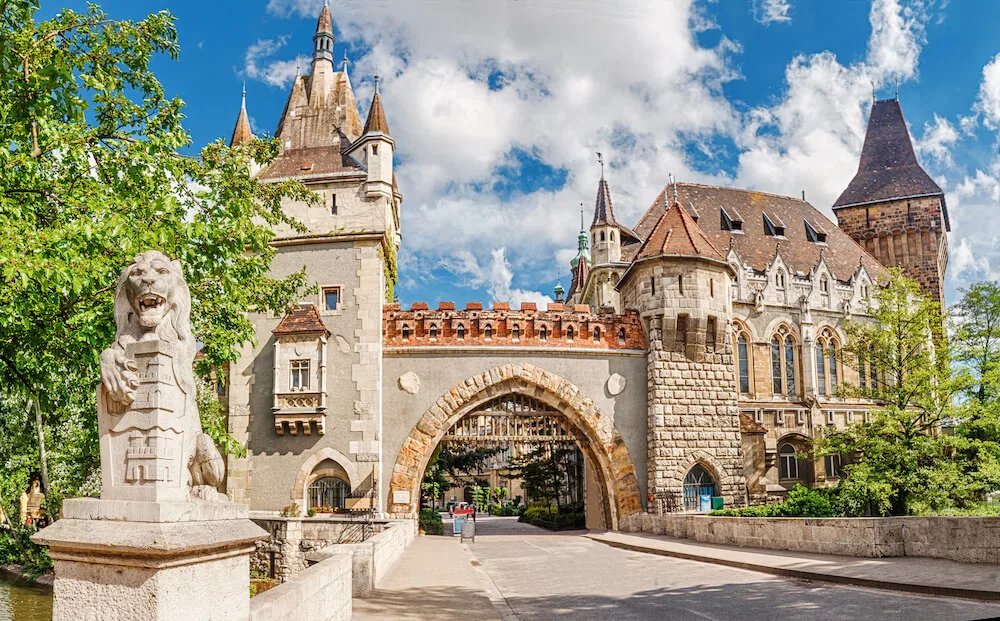
Vajdahunyad Castle
 Highlight of Szechenyi Baths and Nearby
Highlight of Szechenyi Baths and NearbyThis fantastical castle with a boating lake shows the evolution of Hungarian architecture in its elaborate design.
Built for the 1896 Millenium celebrations as a temporary exhibit, the castle proved so popular that it was rebuilt as a permanent structure. It's divided into sections by architectural style as a demonstration of the historical phases of Hungary. Each section is fashioned after a renowned Hungarian example of that architectural style.
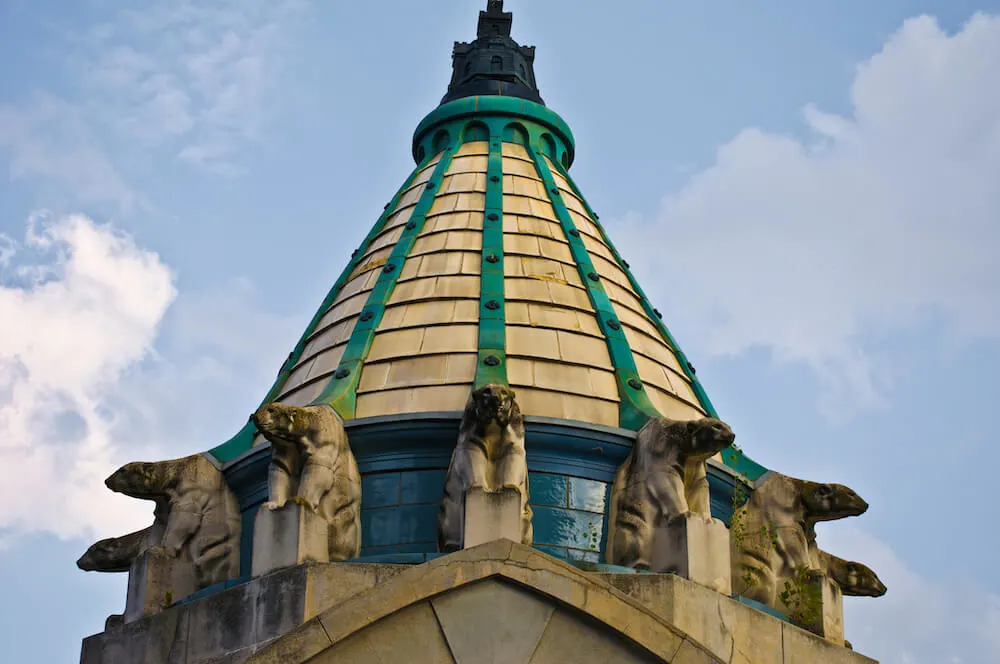
Budapest Zoo
 Highlight of Szechenyi Baths and Nearby
Highlight of Szechenyi Baths and NearbyOne of Europe's most enjoyable zoos with hundreds of animal species and historic architecture throughout the park.
The Secession style architecture of the buildings is a delight, incorporating animals and natural themes into the structures. Adjacent to the zoo is Holnemvolt Park, which combines animal exhibits with theme park rides. One ticket covers both.
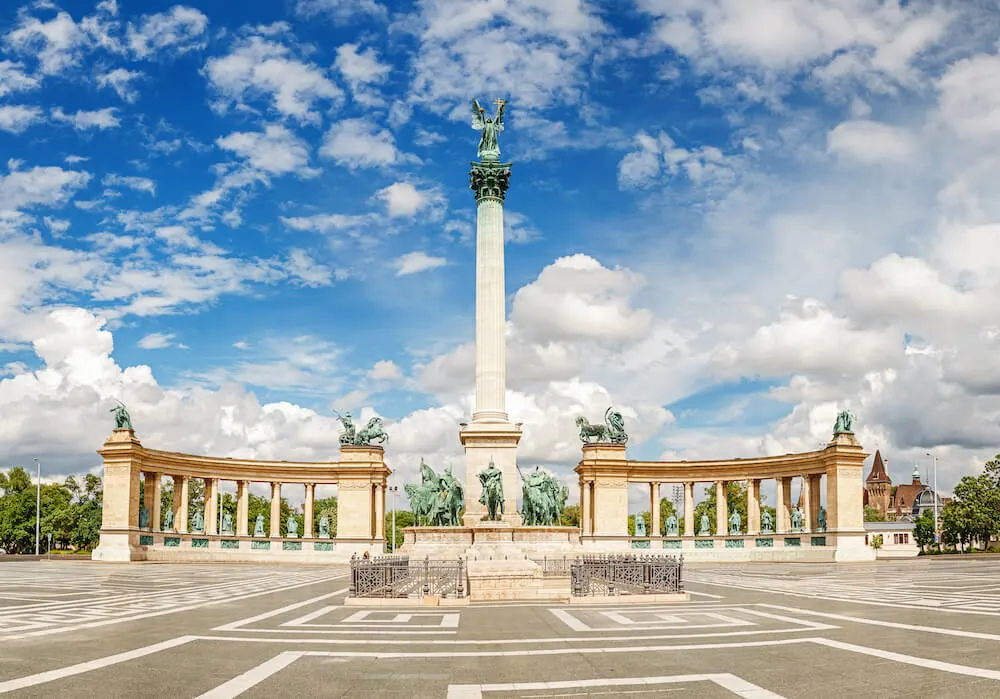
Heroes' Square
 Highlight of Szechenyi Baths and Nearby
Highlight of Szechenyi Baths and NearbyA dramatic square at the end of Adrássy Avenue, displaying statues of the leaders of 7 tribes who founded Hungary.
The vast square was the center of the Millenium celebrations in 1896, which celebrated Hungary's 1,000th anniversary. The Millenium Monument features a central column and two massive colonnades. The column is topped by the Archangel Gabriel, who offered the crown to Hungary's first king, Stephen. Along the base of the column and colonnades are romantic representations of Hungarian historical figures. The two chariots atop the colonnades represent war and peace.

Vajdahunyad Castle
 Highlight of Szechenyi Baths and Nearby
Highlight of Szechenyi Baths and NearbyThis fantastical castle with a boating lake shows the evolution of Hungarian architecture in its elaborate design.
Built for the 1896 Millenium celebrations as a temporary exhibit, the castle proved so popular that it was rebuilt as a permanent structure. It's divided into sections by architectural style as a demonstration of the historical phases of Hungary. Each section is fashioned after a renowned Hungarian example of that architectural style.

Budapest Zoo
 Highlight of Szechenyi Baths and Nearby
Highlight of Szechenyi Baths and NearbyOne of Europe's most enjoyable zoos with hundreds of animal species and historic architecture throughout the park.
The Secession style architecture of the buildings is a delight, incorporating animals and natural themes into the structures. Adjacent to the zoo is Holnemvolt Park, which combines animal exhibits with theme park rides. One ticket covers both.

Heroes' Square
 Highlight of Szechenyi Baths and Nearby
Highlight of Szechenyi Baths and NearbyA dramatic square at the end of Adrássy Avenue, displaying statues of the leaders of 7 tribes who founded Hungary.
The vast square was the center of the Millenium celebrations in 1896, which celebrated Hungary's 1,000th anniversary. The Millenium Monument features a central column and two massive colonnades. The column is topped by the Archangel Gabriel, who offered the crown to Hungary's first king, Stephen. Along the base of the column and colonnades are romantic representations of Hungarian historical figures. The two chariots atop the colonnades represent war and peace.

Vajdahunyad Castle
 Highlight of Szechenyi Baths and Nearby
Highlight of Szechenyi Baths and NearbyThis fantastical castle with a boating lake shows the evolution of Hungarian architecture in its elaborate design.
Built for the 1896 Millenium celebrations as a temporary exhibit, the castle proved so popular that it was rebuilt as a permanent structure. It's divided into sections by architectural style as a demonstration of the historical phases of Hungary. Each section is fashioned after a renowned Hungarian example of that architectural style.
prev
next


Day 20
Budapest
View More
Day 20
Budapest



Morning
Hungarian Parliament and its Surroundings
The Hungarian Parliament building is a magnificent sight as it rises above the waters of the Danube, and the interior is also quite jaw-dropping. As a visitor, you may even feel a bit overwhelmed by the sumptuous décor and attention-to-detail. You could be forgiven for expecting a queen to arrive or an aristocratic ball to break out at any moment.

Former Museum of Ethnography
This building once housed the Hungarian Supreme Court and the Ethnographic museum. The museum is relocating to City Park and will open in 2022.
Show More

Shoes on the Danube Bank
Reflect at a waterside sculpture of shoes memorializing the victims of fascism who died at this spot.
Show More

Hungarian Parliament
Tour this massive and stunning Gothic Revival–style edifice with a guide.
Show More

Former Museum of Ethnography
This building once housed the Hungarian Supreme Court and the Ethnographic museum. The museum is relocating to City Park and will open in 2022.
Show More

Shoes on the Danube Bank
Reflect at a waterside sculpture of shoes memorializing the victims of fascism who died at this spot.
Show More

Hungarian Parliament
Tour this massive and stunning Gothic Revival–style edifice with a guide.
Show More

Former Museum of Ethnography
This building once housed the Hungarian Supreme Court and the Ethnographic museum. The museum is relocating to City Park and will open in 2022.
Show More
prev
next

Day 20
Budapest
View More


Former Museum of Ethnography
 Highlight of Hungarian Parliament & Nearby
Highlight of Hungarian Parliament & NearbyThis building once housed the Hungarian Supreme Court and the Ethnographic museum. The museum is relocating to City Park and will open in 2022.
It was the second place winner in the competition to design the Hungarian Parliament. Many believe it is as beautiful at the Parliament, especially it's interiors.
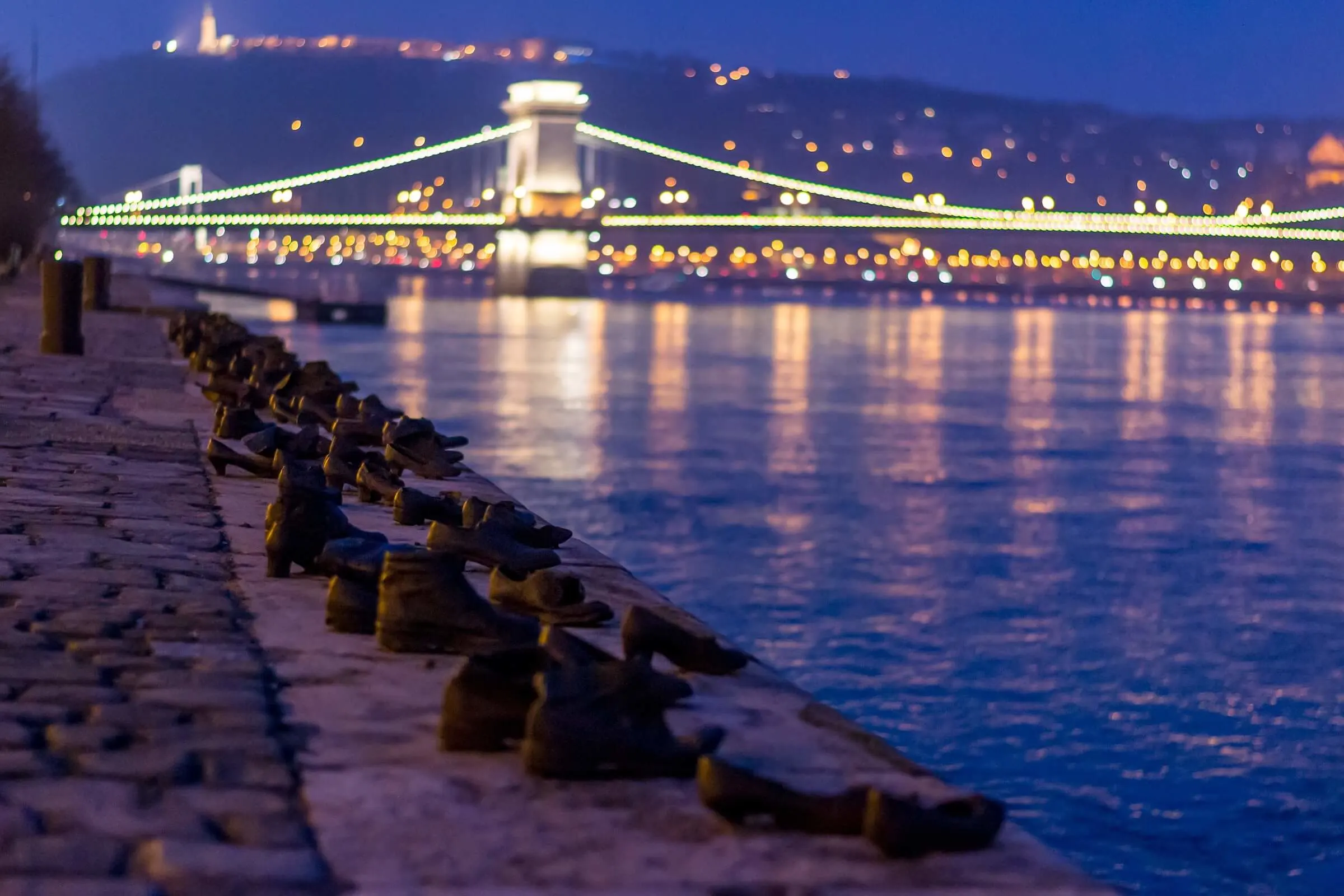
Shoes on the Danube Bank
 Highlight of Hungarian Parliament & Nearby
Highlight of Hungarian Parliament & NearbyReflect at a waterside sculpture of shoes memorializing the victims of fascism who died at this spot.
This moving memorial consists of empty shoes by the riverbank. Near the end of World War II a fascist party took control in Hungary. Jews were lined up along the river bank, forced to step out of their shoes (so they could be collected later), and then machine gunned into the river.

Hungarian Parliament
 Highlight of Hungarian Parliament & Nearby
Highlight of Hungarian Parliament & NearbyTour this massive and stunning Gothic Revival–style edifice with a guide.
The Parliament is ostentatious, but undeniably grand and beautiful. A teeming mass of spires, arches, and towers surrounds the central dome, beneath which the royal crown of Hungary lies under armed guard. Tours of the lavish interiors include the crown, parliament chambers, and grand entry hall. Pre-purchasing tickets is recommended as they often sell out well in advance.

Former Museum of Ethnography
 Highlight of Hungarian Parliament & Nearby
Highlight of Hungarian Parliament & NearbyThis building once housed the Hungarian Supreme Court and the Ethnographic museum. The museum is relocating to City Park and will open in 2022.
It was the second place winner in the competition to design the Hungarian Parliament. Many believe it is as beautiful at the Parliament, especially it's interiors.

Shoes on the Danube Bank
 Highlight of Hungarian Parliament & Nearby
Highlight of Hungarian Parliament & NearbyReflect at a waterside sculpture of shoes memorializing the victims of fascism who died at this spot.
This moving memorial consists of empty shoes by the riverbank. Near the end of World War II a fascist party took control in Hungary. Jews were lined up along the river bank, forced to step out of their shoes (so they could be collected later), and then machine gunned into the river.

Hungarian Parliament
 Highlight of Hungarian Parliament & Nearby
Highlight of Hungarian Parliament & NearbyTour this massive and stunning Gothic Revival–style edifice with a guide.
The Parliament is ostentatious, but undeniably grand and beautiful. A teeming mass of spires, arches, and towers surrounds the central dome, beneath which the royal crown of Hungary lies under armed guard. Tours of the lavish interiors include the crown, parliament chambers, and grand entry hall. Pre-purchasing tickets is recommended as they often sell out well in advance.

Former Museum of Ethnography
 Highlight of Hungarian Parliament & Nearby
Highlight of Hungarian Parliament & NearbyThis building once housed the Hungarian Supreme Court and the Ethnographic museum. The museum is relocating to City Park and will open in 2022.
It was the second place winner in the competition to design the Hungarian Parliament. Many believe it is as beautiful at the Parliament, especially it's interiors.
prev
next


Day 21
Depart Budapest
View More
Day 21
Depart Budapest

To Be Determined
Transfer to Airport by Taxi
Budapest has one main airport, Budapest Ferenc Liszt International Airport, where almost all visitors depart. Your hotel can arrange a reliable taxi (there is no Uber in Budapest). You can also arrange a private transfer. If you are picked up about two hours and forty-five minutes before your departure time, you should arrive at the airport with about two hours to spare, depending on traffic. If you are leaving during rush hour, you may want to budget an extra fifteen to thirty minutes.

Day 21
Depart Budapest
View More


What's Included In Your Trip

Pre-Paid Tours and Activities:
- Private Guided Walking Tour of the Center of Paris
- Canal Cruise in Amsterdam
- Privately Guided Walking Tour of Amsterdam
- Highlights of Berlin Guided Walking Tour
- Prague Castle & Royal Route Guided Walk
- Guided Walk through Vienna's Inner City
- Best of Budapest: Half-Day Walking Tour of Highlights & Hidden Finds
- City Cards for Berlin and Amsterdam, including discounts to many popular attractions

Pre-Paid Transportation:
- 2nd Class Train Tickets from Paris-Amsterdam
- 2nd Class Train Tickets from Amsterdam-Berlin
- 2nd Class Train Tickets from Berlin to Prague
- 2nd Class Train Tickets from Prague to Vienna
- 2nd Class Train Tickets from Vienna to Budapest
- Public Transport Tickets for Budapest, Berlin, Vienna, and Amsterdam
- Private Transfer from the Budapest Rail Station

Accommodation:
- 5 nights at a hotel of your choice in Paris
- 4 nights at a hotel of your choice in Amsterdam
- 4 nights at a hotel of your choice in Berlin
- 4 nights at a hotel of your choice in Prague
- 4 nights at a hotel of your choice in Vienna
- 5 nights at a hotel of your choice in Budapest

Go Real Travel Mobile App:
- Itinerary Plan & Reservations Info
- Points of Interest
- Detailed Travel Information
- Maps & Directions
Other Trips You May Like

15 Days
From$2750USD
Prague, Vienna, and Budapest, 15 Days of Must See Sights & Local Scenes

Czech Republic, Austria, Hungary

9 Days
From$2240USD
Capitals, Canals, and Castles: A 9-Day Tour of Amsterdam, Berlin, and Prague

Netherlands, Germany, Czech Republic

8 Days
From$1425USD
Enchanting Central Europe: 8-Days in Prague, Vienna & Budapest

Czech Republic, Austria, Hungary

12 Days
From$2675USD
Jewish Heritage and Scenic Rivers: A Journey through Prague, Vienna, and Budapest

Hungary, Austria, Czech Republic

12 Days
From$2399USD
Europe's Urban Treasures: Paris, Prague, Vienna, and Budapest

France, Czech Republic, Austria, Hungary

14 Days
From$2875USD
2-Week Journey Through Central & Eastern Europe: History

Germany, Czech Republic, Austria, Hungary, Poland

14 Days
From$2350USD
Imperial Elegance: Prague, Vienna and Budapest Itinerary 14 Days

Czech Republic, Austria, Hungary

7 Days
From$1489USD
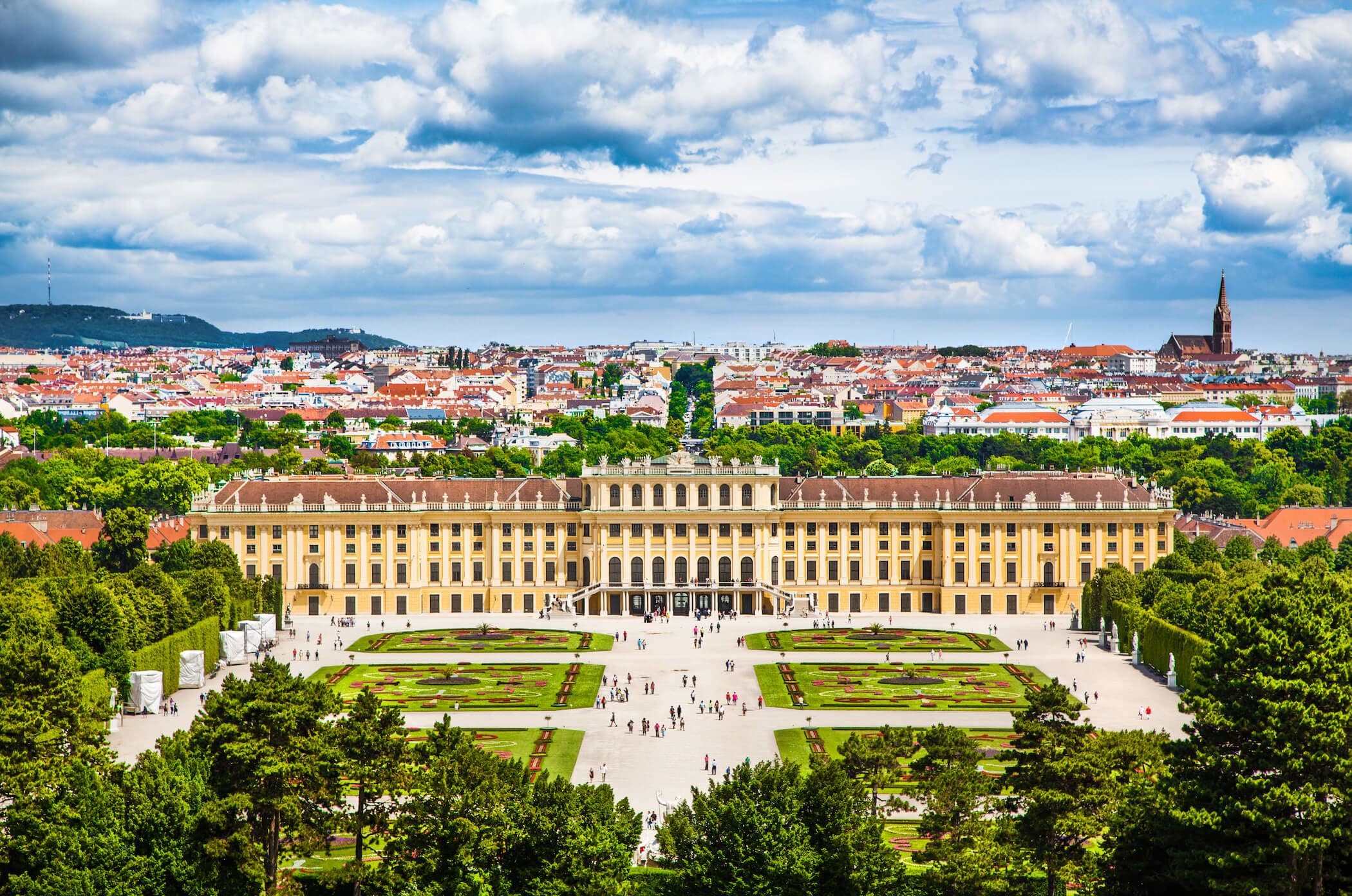
11 Days
From$2045USD
11 Day Itinerary in Berlin, Prague & Vienna: Castles, Palaces, and Much More

Germany, Czech Republic, Austria

15 Days
From$2750USD
Prague, Vienna, and Budapest, 15 Days of Must See Sights & Local Scenes

Czech Republic, Austria, Hungary

9 Days
From$2240USD
Capitals, Canals, and Castles: A 9-Day Tour of Amsterdam, Berlin, and Prague

Netherlands, Germany, Czech Republic

8 Days
From$1425USD
Enchanting Central Europe: 8-Days in Prague, Vienna & Budapest

Czech Republic, Austria, Hungary

12 Days
From$2675USD
Jewish Heritage and Scenic Rivers: A Journey through Prague, Vienna, and Budapest

Hungary, Austria, Czech Republic

12 Days
From$2399USD
Europe's Urban Treasures: Paris, Prague, Vienna, and Budapest

France, Czech Republic, Austria, Hungary

14 Days
From$2875USD
2-Week Journey Through Central & Eastern Europe: History

Germany, Czech Republic, Austria, Hungary, Poland

14 Days
From$2350USD
Imperial Elegance: Prague, Vienna and Budapest Itinerary 14 Days

Czech Republic, Austria, Hungary

7 Days
From$1489USD

11 Days
From$2045USD
11 Day Itinerary in Berlin, Prague & Vienna: Castles, Palaces, and Much More

Germany, Czech Republic, Austria
prev
next
Featured Blogs
prev
next
Our Customers Say It Best
Otto Chuy, Los Angeles, California
I am still surprised how everything worked as planned, without a hitch. All instructions in your itinerary were precise and correct. Your suggestions and comments in each of the locations we went to were very helpful. All your guides, without exception, were wonderful and exactly on time. 

Kathy Mongeau, Ottawa, Ontario
My sister, Ann Ibberson, and I have been back home for a few weeks now and still go on and on about our fabulous trip. We were just blown away in every respect. Given the fact that we only had 1 ½ weeks, you had everything arranged for us so efficiently and your contacts who we dealt with for transfers, tours, hotels were extremely professional and personable. Things could not have gone better. 

Clive Andrew, Brisbane, Queensland
Just a quick note to let you know that I am back home now after probably the best overseas holiday that I have ever had, in no small part due to your very capable organization booking of hotels, tours, & trains. There was just nothing that went wrong with the timings etc. 

Malini Dutta, Boston, Massachusetts
We can't thank you enough for the detailed plans, maps, and suggestions. It really felt that someone was holding our hands and showing us around. We had all the excitement of discovering foreign lands, with none of the problems that can happen while negotiating unfamiliar places. In fact, all the cities felt like home within a few hours of arriving and exploring. 

Bev and Mark Frankel, Williamsburg, Virginia
We could not be more pleased with Go Real Travel! You took the guess work out of things like public transport but still managed to allow us the freedom to tour as we wanted. Our guides were exceptional and every time I saw a Viking Cruise tour of 25 people, I realized the quality experience we were getting with Go Real. 

Marianne Strydom, Paarl, South Africa
I just wanted to thank you for organizing an amazing trip for me – I packed in so much in such a short period of time and everything was just perfect. The way you do things makes it possible to really get to know the destination, which for me as a travel agent could not have been better. 

Otto Chuy, Los Angeles, California
I am still surprised how everything worked as planned, without a hitch. All instructions in your itinerary were precise and correct. Your suggestions and comments in each of the locations we went to were very helpful. All your guides, without exception, were wonderful and exactly on time. 

Kathy Mongeau, Ottawa, Ontario
My sister, Ann Ibberson, and I have been back home for a few weeks now and still go on and on about our fabulous trip. We were just blown away in every respect. Given the fact that we only had 1 ½ weeks, you had everything arranged for us so efficiently and your contacts who we dealt with for transfers, tours, hotels were extremely professional and personable. Things could not have gone better. 

Clive Andrew, Brisbane, Queensland
Just a quick note to let you know that I am back home now after probably the best overseas holiday that I have ever had, in no small part due to your very capable organization booking of hotels, tours, & trains. There was just nothing that went wrong with the timings etc. 

Malini Dutta, Boston, Massachusetts
We can't thank you enough for the detailed plans, maps, and suggestions. It really felt that someone was holding our hands and showing us around. We had all the excitement of discovering foreign lands, with none of the problems that can happen while negotiating unfamiliar places. In fact, all the cities felt like home within a few hours of arriving and exploring. 

Bev and Mark Frankel, Williamsburg, Virginia
We could not be more pleased with Go Real Travel! You took the guess work out of things like public transport but still managed to allow us the freedom to tour as we wanted. Our guides were exceptional and every time I saw a Viking Cruise tour of 25 people, I realized the quality experience we were getting with Go Real. 

Marianne Strydom, Paarl, South Africa
I just wanted to thank you for organizing an amazing trip for me – I packed in so much in such a short period of time and everything was just perfect. The way you do things makes it possible to really get to know the destination, which for me as a travel agent could not have been better. 



Explore cities in more detail

Prague
The city of Prague is indisputably the gem of Central Europe. Full of history, culture, and classic Czech pubs around every corner, Prague is teeming with nooks and crannies just waiting to be discovered. The narrow cobblestone streets and warm red rooftops give the city a homey feel, while the well-preserved medieval architecture transports you back in time. Walking across the Charles Bridge with the view of the Prague Castle will make you feel like you’re living in a fairytale, and you might as well be. As an up-and-coming destination, Prague is a perfect mix of classic and modern. New trendy cafes and bistros are always popping up, and you can always find a group of lively locals chowing down on goulash and quaffing pivo (the best beer in Europe!) at traditional Czech restaurants across the city. The clash of modernity and tradition, preservation and innovation, gives this city a mysterious air that you won’t soon forget.
Read More
Learn About Prague
Build Prague Trip

Vienna
Artistic and musical, historical and elegant, Vienna is the definition of class. The seat of the Habsburg monarchy for over six centuries, it's no wonder this city is still fit for royalty. Baroque buildings and imperial palaces dominate the cityscape, while locals stride gracefully through the streets, likely on their way to a classical music concert or art exhibition. Visitors from all over the world flock to Schonbrunn Palace, historical museums, and local eateries for authentic Viennese schnitzel. Vienna is also home to world-class wining and dining. Famous dishes include Wiener schnitzel, Tafelspitz (prime boiled beef), and apfelstrudel (apple strudel), all of which pair well with a glass of fine Austrian wine. No matter how long you spend in Vienna, you'll leave with a new appreciation for the finer things in life.
Read More
Learn About Vienna
Build Vienna Trip
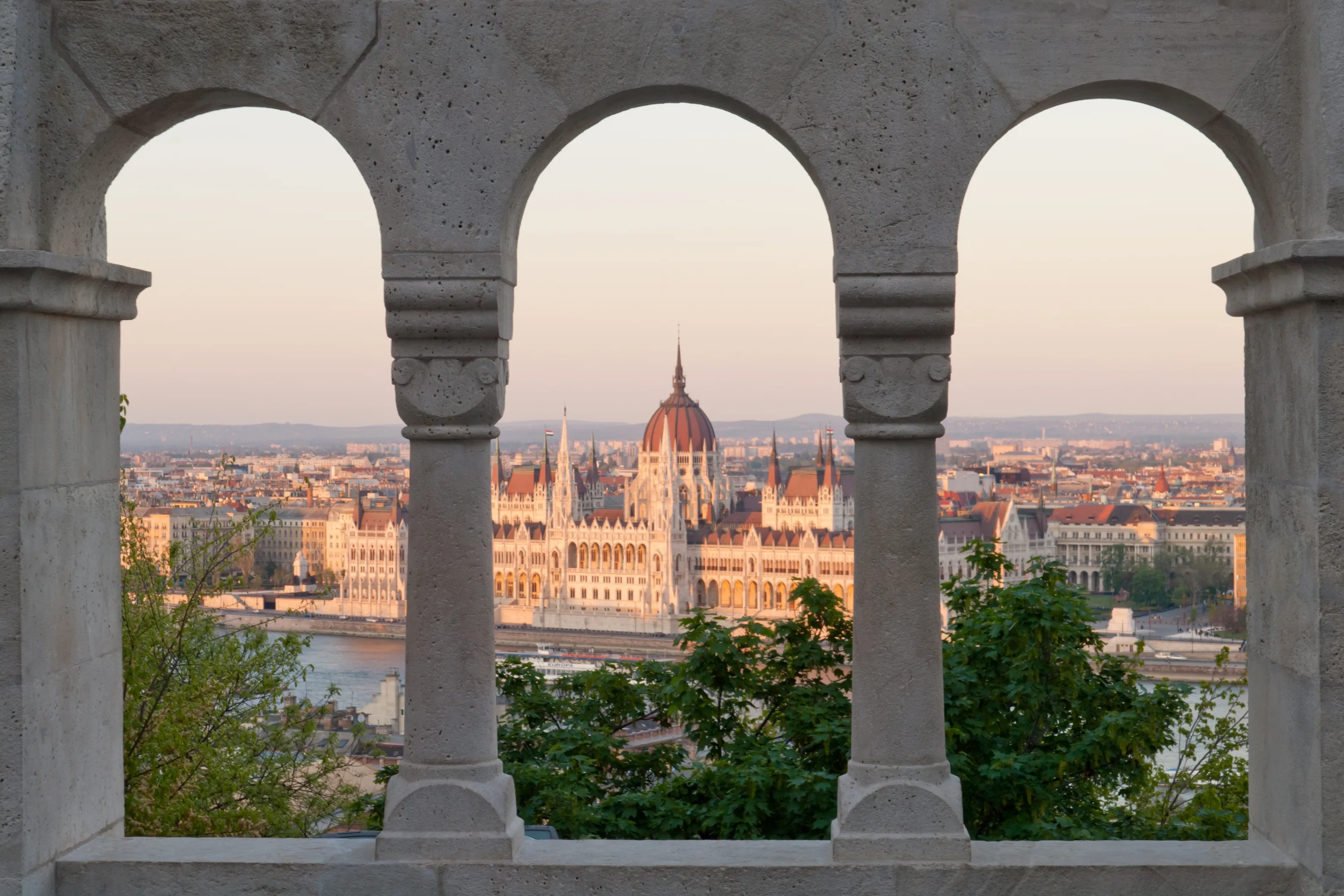
Budapest
Situated at the heart of Europe, Budapest is the capital of Hungary, appropriately named 'The Pearl of the Danube,' for its fixating and almost haunting beauty. Formerly two separate cities, Buda and Pest were forged into one by time, occupation, and the eight bridges that anchor them together today. From the Romans to the Communists, each occupier left its flavor profile in Budapest, evident in the famous spicy Hungarian stew known as 'goulash.' Budapest is a melting pot of history, culture, and taste, from the magnificent Baroque and neo-Gothic architecture to the Turkish thermal baths. After a long day of sightseeing, treat yourself to a glass of Tokaj, what King Louis XIV of France referred to as the "Wine of Kings, King of Wines". Budapest has a flavor to satisfy any taste.
Read More
Learn About Budapest
Build Budapest Trip
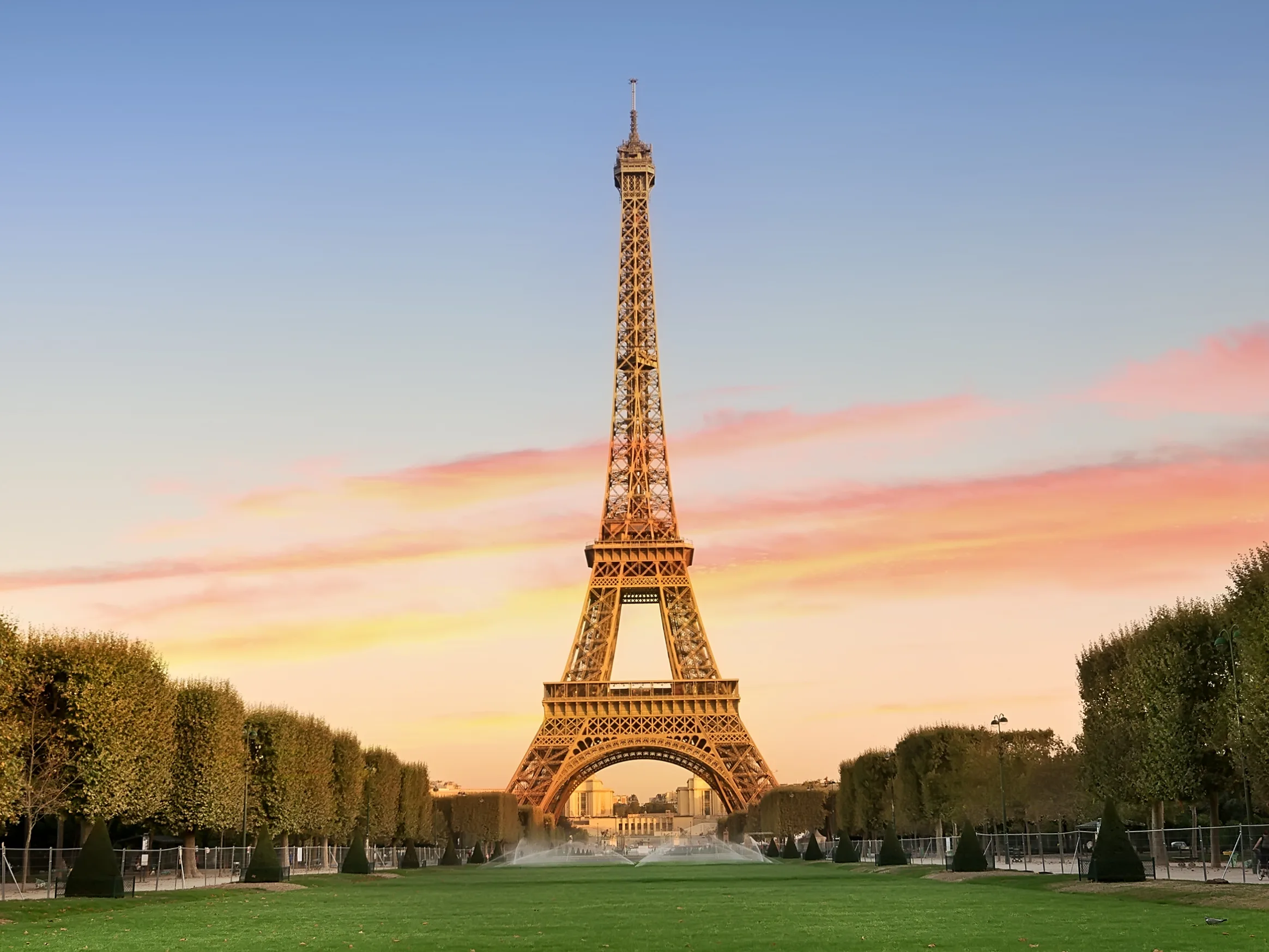
Paris
The magic of Paris is undeniable. This is the most romantic destination in Europe, and surely the number one bucket list destination of all time. If you want to say you've traveled, you have to visit Paris at least once. Along with classic must-sees like the Eiffel Tower and the Sacre-Coeur, there is so much to see and do in Paris that it helps to narrow it down by interest. Fashion and shopping enthusiast? Look no further than the Galeries Lafayette, Avenue des Champs-Élysées, or the Marais. Art aficionado? Once you're done with the Louvre, make a start on the Musée d'Orsay. History buffs won't be able to walk a block without uncovering a monument to Napoleon or Louis XIV. If you visit Paris with a foodie, be warned — you'll gaze in a lot of patisserie windows, and sample your weight in croissants. Because Paris always has so much on offer, it never grows old. At dusk, as you stroll the wide boulevards past Haussmann apartment buildings and sharply dressed Parisians, or gaze down at the city from the hill at Montmarte, you might find yourself saying 'Paris Je t' aime'. This is, after all, the City of Love.
Read More
Learn About Paris
Build Paris Trip
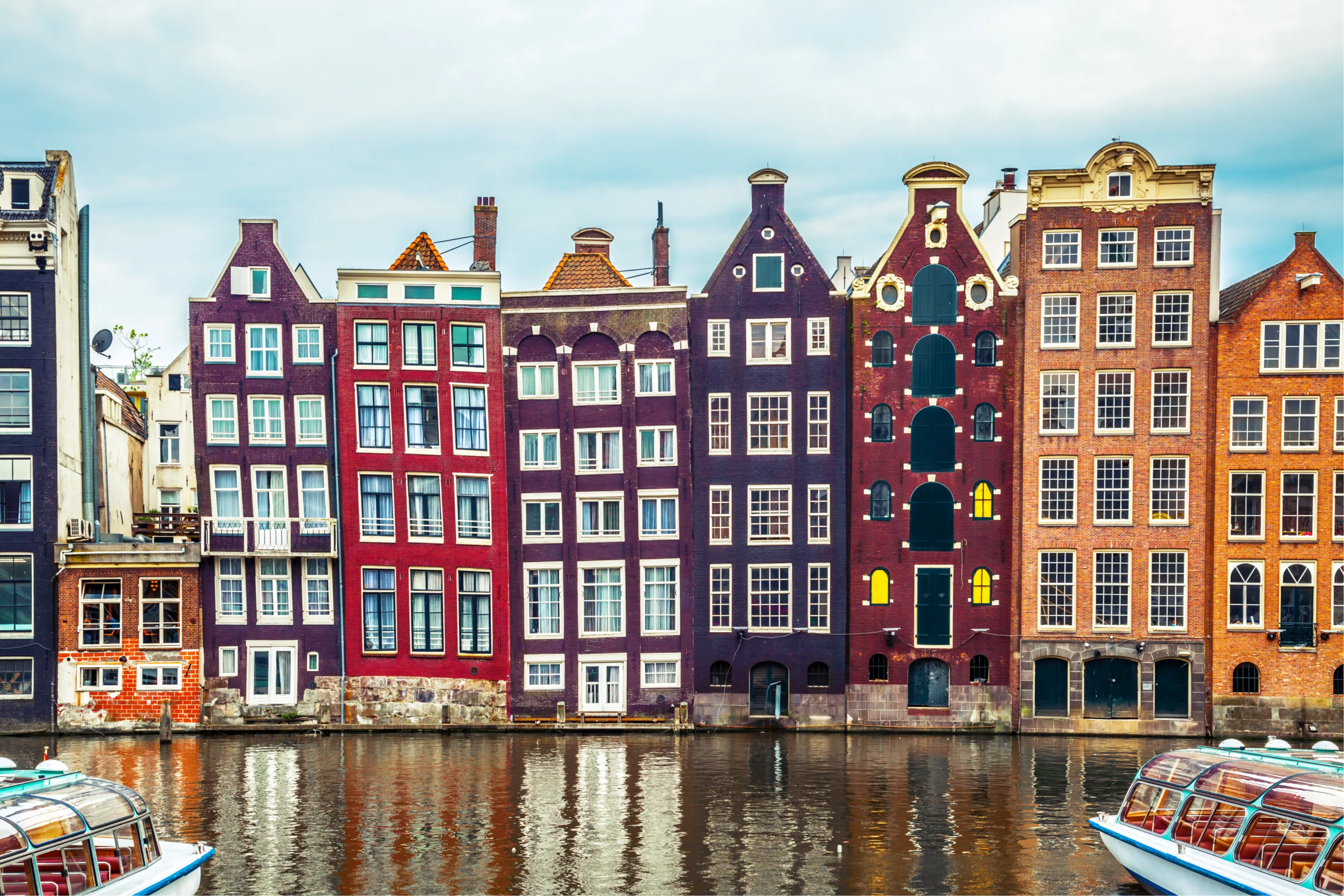
Amsterdam
A waterside metropolis with a low-key vibe, a visit to Amsterdam is as fun and freewheeling as a fixed-gear bicycle. This is the city where you can let it all go. The streets of Amsterdam chime with bicycle bells and the laughter of people making their way between bars. Yellow wheels of cheese line shop windows, and in springtime, market stalls are abundant with the famous Dutch tulips. Younger than other cities in the Netherlands, Amsterdam sprang to life in the 17th century, when it became flush with trade from the Dutch colonies. From the gable tipped houses standing shoulder-to-shoulder on the canals to the Rembrandt paintings hanging on the walls of the Rijksmuseum, Amsterdam is strewn with relics from the Dutch Golden Age. Whether you rent a bicycle, float down a canal, or just sip on an amber-colored lager and watch the world go by, Amsterdam makes a lasting impression from start to finish.
Read More
Learn About Amsterdam
Build Amsterdam Trip
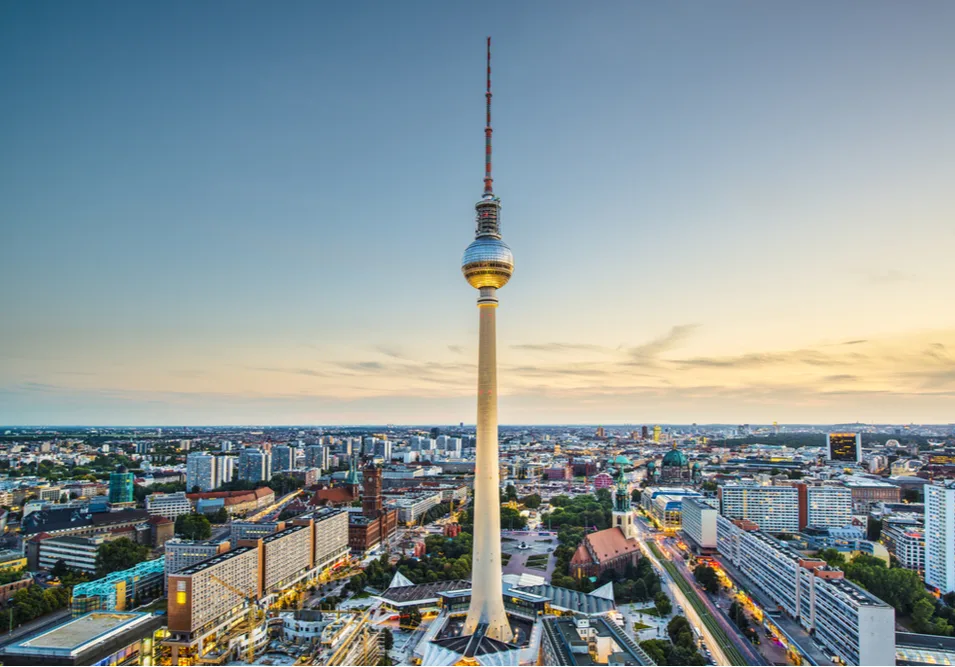
Berlin
Since the fall of its notorious wall, Berlin’s unification has seen it go from strength to strength. No wonder the city feels like it hasn’t stopped partying since the 1990s. There is so much to celebrate here. Fueled by the robust economy, a thriving tech scene, and straight-up German bonhomie, when you step into Berlin you’ll soon be caught up in its spirit. For all this gusto, Berlin hasn’t forgotten its troubled past. A visit to Berlin is to bear witness to history. Portions of the wall remain intact, and the city’s Jewish Museum offers a detailed, emotional examination of the Holocaust. Inside the reconstructed Reichstag, every attempt has been made to preserve the parliament’s beleaguered history. The buildings' glass dome addition feels less like a triumphal crown and more like a freshly healed battle scar. Days in Berlin are easily spent wandering from a cafe to the cultural institutions on Museum Island, or over to the Charlottenburg Palace. By night, crowds wander through the booming bars and nightclubs or gaze upon the floodlit Brandenburg Gate and Victory Column monuments. An international city that can offer something to everyone, Berlin is an unmissable stop on your German journey.
Read More
Learn About Berlin
Build Berlin Trip

Prague
The city of Prague is indisputably the gem of Central Europe. Full of history, culture, and classic Czech pubs around every corner, Prague is teeming with nooks and crannies just waiting to be discovered. The narrow cobblestone streets and warm red rooftops give the city a homey feel, while the well-preserved medieval architecture transports you back in time. Walking across the Charles Bridge with the view of the Prague Castle will make you feel like you’re living in a fairytale, and you might as well be. As an up-and-coming destination, Prague is a perfect mix of classic and modern. New trendy cafes and bistros are always popping up, and you can always find a group of lively locals chowing down on goulash and quaffing pivo (the best beer in Europe!) at traditional Czech restaurants across the city. The clash of modernity and tradition, preservation and innovation, gives this city a mysterious air that you won’t soon forget.
Read More
Learn About Prague
Build Prague Trip

Vienna
Artistic and musical, historical and elegant, Vienna is the definition of class. The seat of the Habsburg monarchy for over six centuries, it's no wonder this city is still fit for royalty. Baroque buildings and imperial palaces dominate the cityscape, while locals stride gracefully through the streets, likely on their way to a classical music concert or art exhibition. Visitors from all over the world flock to Schonbrunn Palace, historical museums, and local eateries for authentic Viennese schnitzel. Vienna is also home to world-class wining and dining. Famous dishes include Wiener schnitzel, Tafelspitz (prime boiled beef), and apfelstrudel (apple strudel), all of which pair well with a glass of fine Austrian wine. No matter how long you spend in Vienna, you'll leave with a new appreciation for the finer things in life.
Read More
Learn About Vienna
Build Vienna Trip

Budapest
Situated at the heart of Europe, Budapest is the capital of Hungary, appropriately named 'The Pearl of the Danube,' for its fixating and almost haunting beauty. Formerly two separate cities, Buda and Pest were forged into one by time, occupation, and the eight bridges that anchor them together today. From the Romans to the Communists, each occupier left its flavor profile in Budapest, evident in the famous spicy Hungarian stew known as 'goulash.' Budapest is a melting pot of history, culture, and taste, from the magnificent Baroque and neo-Gothic architecture to the Turkish thermal baths. After a long day of sightseeing, treat yourself to a glass of Tokaj, what King Louis XIV of France referred to as the "Wine of Kings, King of Wines". Budapest has a flavor to satisfy any taste.
Read More
Learn About Budapest
Build Budapest Trip

Paris
The magic of Paris is undeniable. This is the most romantic destination in Europe, and surely the number one bucket list destination of all time. If you want to say you've traveled, you have to visit Paris at least once. Along with classic must-sees like the Eiffel Tower and the Sacre-Coeur, there is so much to see and do in Paris that it helps to narrow it down by interest. Fashion and shopping enthusiast? Look no further than the Galeries Lafayette, Avenue des Champs-Élysées, or the Marais. Art aficionado? Once you're done with the Louvre, make a start on the Musée d'Orsay. History buffs won't be able to walk a block without uncovering a monument to Napoleon or Louis XIV. If you visit Paris with a foodie, be warned — you'll gaze in a lot of patisserie windows, and sample your weight in croissants. Because Paris always has so much on offer, it never grows old. At dusk, as you stroll the wide boulevards past Haussmann apartment buildings and sharply dressed Parisians, or gaze down at the city from the hill at Montmarte, you might find yourself saying 'Paris Je t' aime'. This is, after all, the City of Love.
Read More
Learn About Paris
Build Paris Trip

Amsterdam
A waterside metropolis with a low-key vibe, a visit to Amsterdam is as fun and freewheeling as a fixed-gear bicycle. This is the city where you can let it all go. The streets of Amsterdam chime with bicycle bells and the laughter of people making their way between bars. Yellow wheels of cheese line shop windows, and in springtime, market stalls are abundant with the famous Dutch tulips. Younger than other cities in the Netherlands, Amsterdam sprang to life in the 17th century, when it became flush with trade from the Dutch colonies. From the gable tipped houses standing shoulder-to-shoulder on the canals to the Rembrandt paintings hanging on the walls of the Rijksmuseum, Amsterdam is strewn with relics from the Dutch Golden Age. Whether you rent a bicycle, float down a canal, or just sip on an amber-colored lager and watch the world go by, Amsterdam makes a lasting impression from start to finish.
Read More
Learn About Amsterdam
Build Amsterdam Trip

Berlin
Since the fall of its notorious wall, Berlin’s unification has seen it go from strength to strength. No wonder the city feels like it hasn’t stopped partying since the 1990s. There is so much to celebrate here. Fueled by the robust economy, a thriving tech scene, and straight-up German bonhomie, when you step into Berlin you’ll soon be caught up in its spirit. For all this gusto, Berlin hasn’t forgotten its troubled past. A visit to Berlin is to bear witness to history. Portions of the wall remain intact, and the city’s Jewish Museum offers a detailed, emotional examination of the Holocaust. Inside the reconstructed Reichstag, every attempt has been made to preserve the parliament’s beleaguered history. The buildings' glass dome addition feels less like a triumphal crown and more like a freshly healed battle scar. Days in Berlin are easily spent wandering from a cafe to the cultural institutions on Museum Island, or over to the Charlottenburg Palace. By night, crowds wander through the booming bars and nightclubs or gaze upon the floodlit Brandenburg Gate and Victory Column monuments. An international city that can offer something to everyone, Berlin is an unmissable stop on your German journey.
Read More
Learn About Berlin
Build Berlin Trip
prev
next


 Map of Your Itinerary Route
Map of Your Itinerary Route
Zoom In to the cities to see your itinerary in more detail


 4.8
4.8 
